Physical Address
304 North Cardinal St.
Dorchester Center, MA 02124
Studies in fracture patterns, soft-tissue management, and outcomes of calcaneal fractures have led to debate about the optimal management of calcaneal fractures. Prospective randomized studies have shown equivocal outcomes with operative and nonoperative treatment. However, recent trends in the literature suggest that restoration of physiologic parameters of length, height, and alignment of the calcaneus may lead to better long-term results. Initial studies using extensile approaches showed higher rates of wound complications with operative treatment; however, recent studies have shown lower complication rates with sinus tarsi and other minimally invasive techniques. Regardless of the treatment, calcaneal fractures are associated with numerous complications and guarded outcomes with significant long-term quality-of-life issues. Outcomes in patients with calcaneal fractures have been shown to be relatively poor, with functional outcome levels similar to patients who underwent organ transplants or sustained myocardial infarctions. Patients with calcaneal fractures should be informed of the potential life-changing nature of this injury and of the prolonged recovery time that is required. Sanders et al. confirmed that the learning curve for operative treatment of this fracture is steep. With substantial literature supporting closed methods of treatment, a thorough knowledge of the anatomy and clearly defined goals are necessary for a successful outcome. Calcaneal fractures present complex challenges for both the orthopaedic surgeon and patient.
Intraarticular fractures account for approximately 75% of calcaneal fractures and historically have been associated with poor functional outcomes. These fractures generally are caused by an axial load mechanism, such as a fall or a motor vehicle accident, and may be associated with other axial load injuries, such as lumbar, pelvic, and tibial plateau fractures. Cadaver studies, anatomic dissections, and the use of CT have allowed a detailed description of the mechanism of injury and the resulting fracture patterns ( Fig. 89.1 ). The contact point of the calcaneus is situated lateral to the weight-bearing axis of the lower extremity. As an axial load force is applied to the posterior facet of the calcaneus through the talus, shear forces are directed through the posterior facet toward the medial wall of the calcaneus ( Fig. 89.2 ). The ensuing fracture (primary fracture line) is almost always present and extends from the proximal-medial aspect of the calcaneal tuberosity, through the anterolateral wall, usually near the crucial angle of Gissane. The most variable aspect of this fracture line is its position through the posterior facet of the calcaneus; it can be in the medial third near the sustentaculum tali, the central third, or the lateral third near the lateral wall.
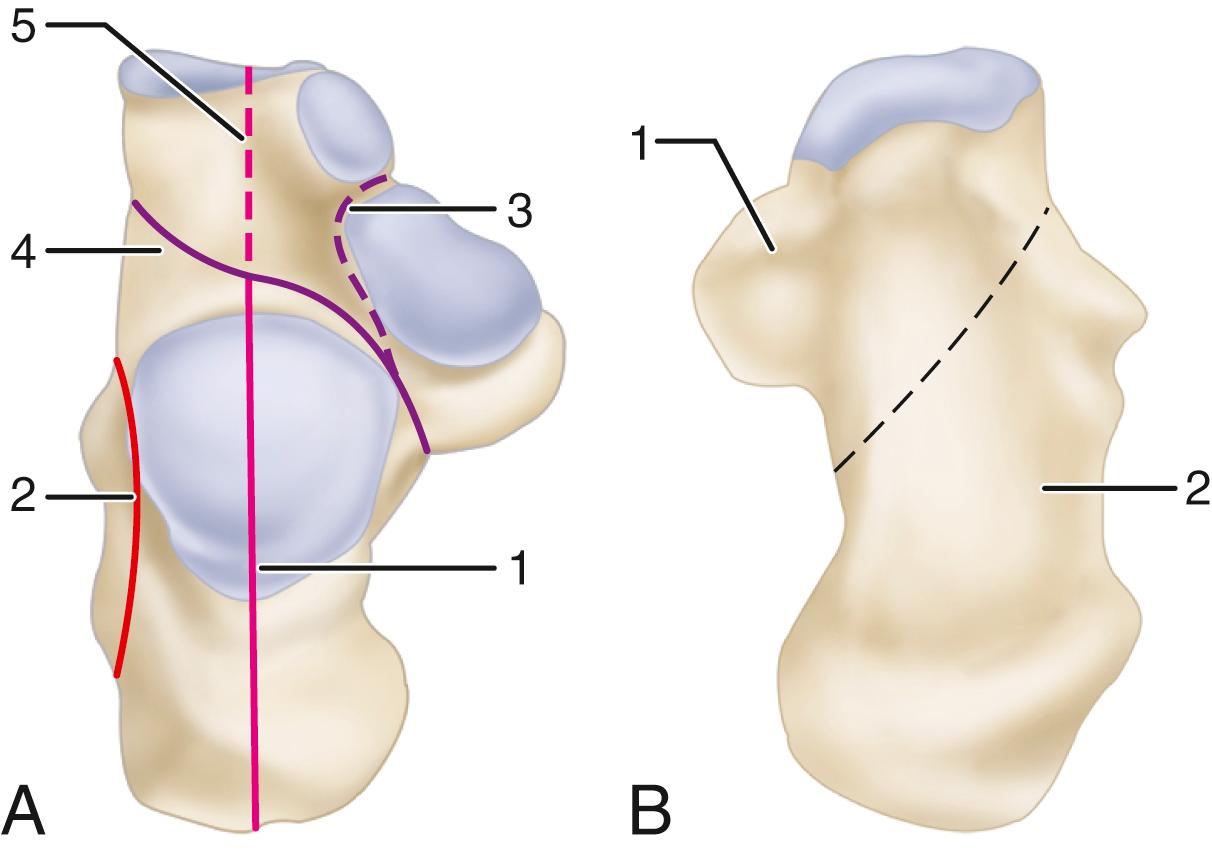
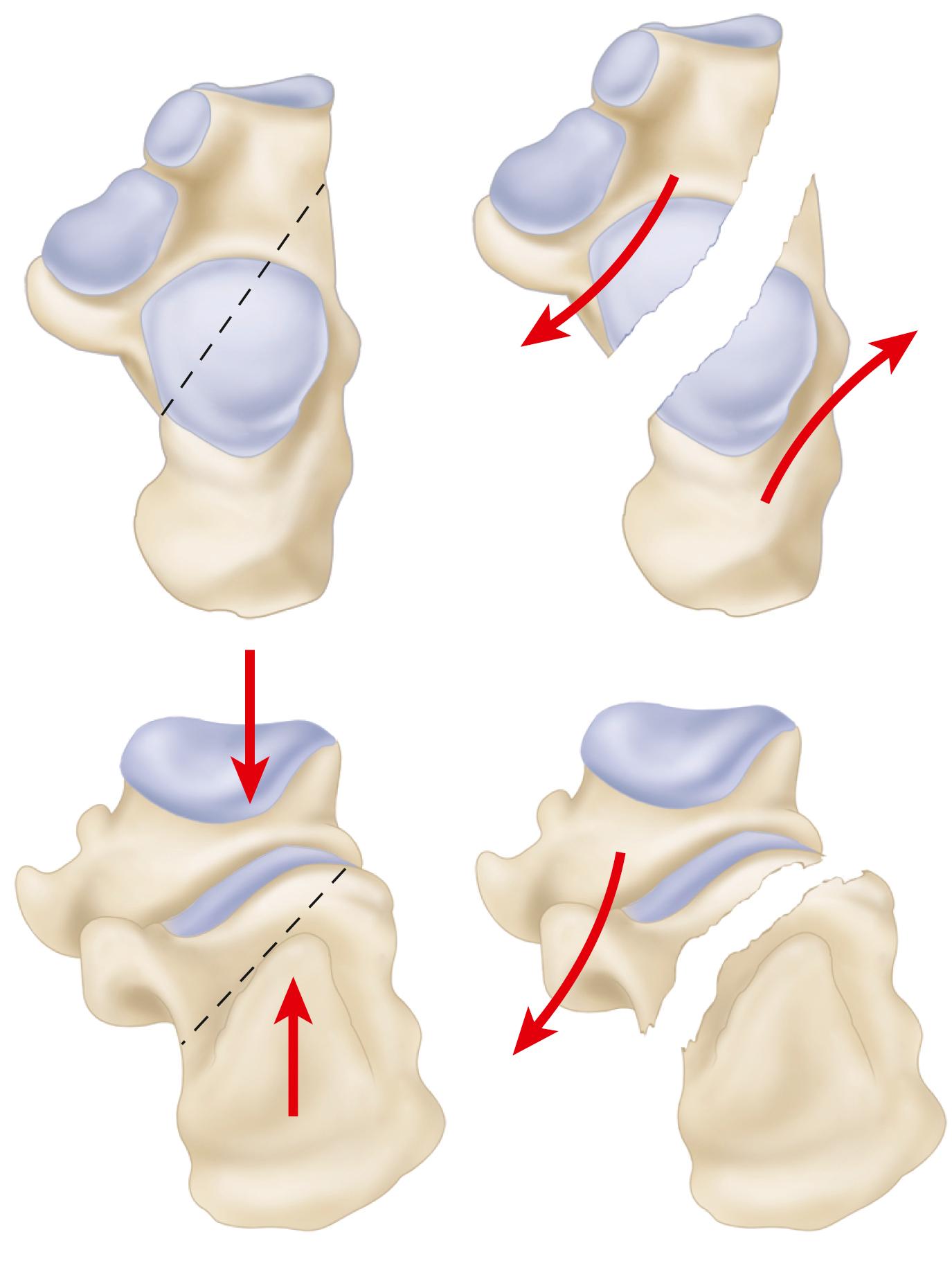
As the axial force continues, two things happen: (1) the medial spike attached to the sustentaculum is pushed farther toward the medial heel skin, and (2) various secondary fracture lines occur in the region of the posterior facet. Often an anterior fracture extends toward the anterior process and may exit into the calcaneocuboid joint. The additional fractures of the posterior facet can be divided into two types, as described by Essex-Lopresti ( Fig. 89.3 ). If the fracture line producing the posterior facet fragment exits behind the posterior facet and anterior to the attachment of the Achilles tendon, the injury is called a joint depression type ( Fig. 89.3C ). If it exits distal to the Achilles tendon insertion, it is called a tongue type ( Fig. 89.3D ).
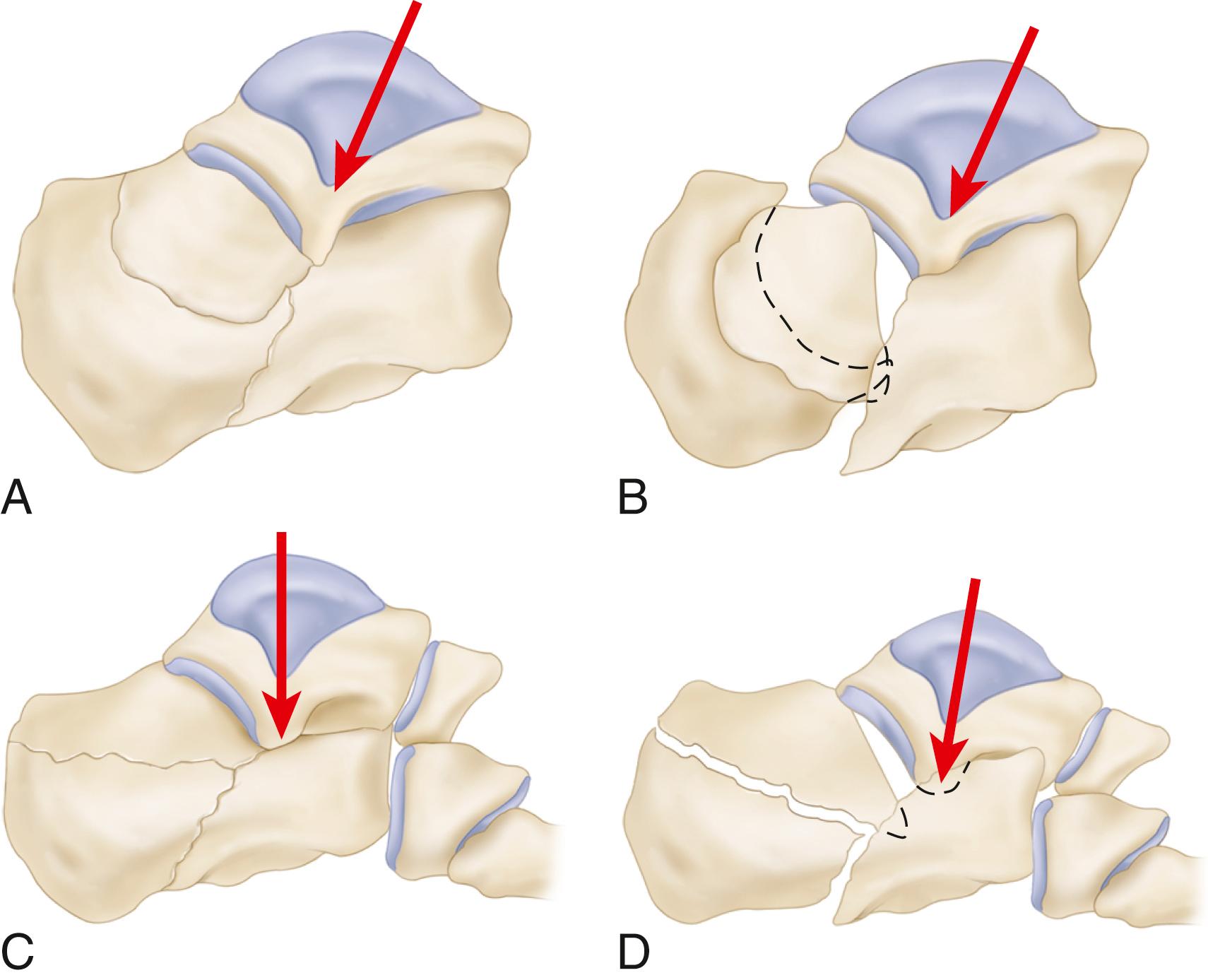
As the talus pushes the posterior facet and the underlying thalamic fragment into the body of the calcaneus, it also pushes out the lateral wall, closing the space for the peroneal tendons and occasionally impinging on the fibula. As the force is removed, recoil of the talus occurs, leaving a depressed thalamic fragment, and the medial spike is retracted into the soft tissues. For this reason, medially open fractures of the calcaneus require deep dissection to expose and irrigate the medial spike thoroughly.
Radiographic evaluation of the fracture should include five views. A lateral radiograph is used to assess height loss (loss of Böhler’s angle) ( Fig. 89.4 ) and rotation of the posterior facet. The axial (or Harris) view is made to assess varus position of the tuberosity and width of the heel. Anteroposterior and oblique views of the foot are made to assess the anterior process and calcaneocuboid involvement. A single Brodén view, obtained by internally rotating the leg 40 degrees with the ankle in neutral, and then angling the beam 10 to 15 degrees cephalad, is made to evaluate congruency of the posterior facet ( Fig. 89.5 ). CT scans should be obtained for full injury evaluation and surgical planning. The scans should be ordered in multiple planes: the semicoronal plane, oriented perpendicular to the normal position of the posterior facet of the calcaneus ( Fig. 89.6 ), the axial plane, oriented parallel to the sole of the foot, and the sagittal plane oriented perpendicular to the sole of the foot. Three-dimensional reconstructions have also been shown to be useful in evaluation and operative planning of calcaneal fractures. The CT scan should be carefully evaluated for additional fractures in the foot, as well as peroneal tendon dislocations and flexor hallucis longus (FHL) position (best evaluated with soft-tissue windows in the axial plane).
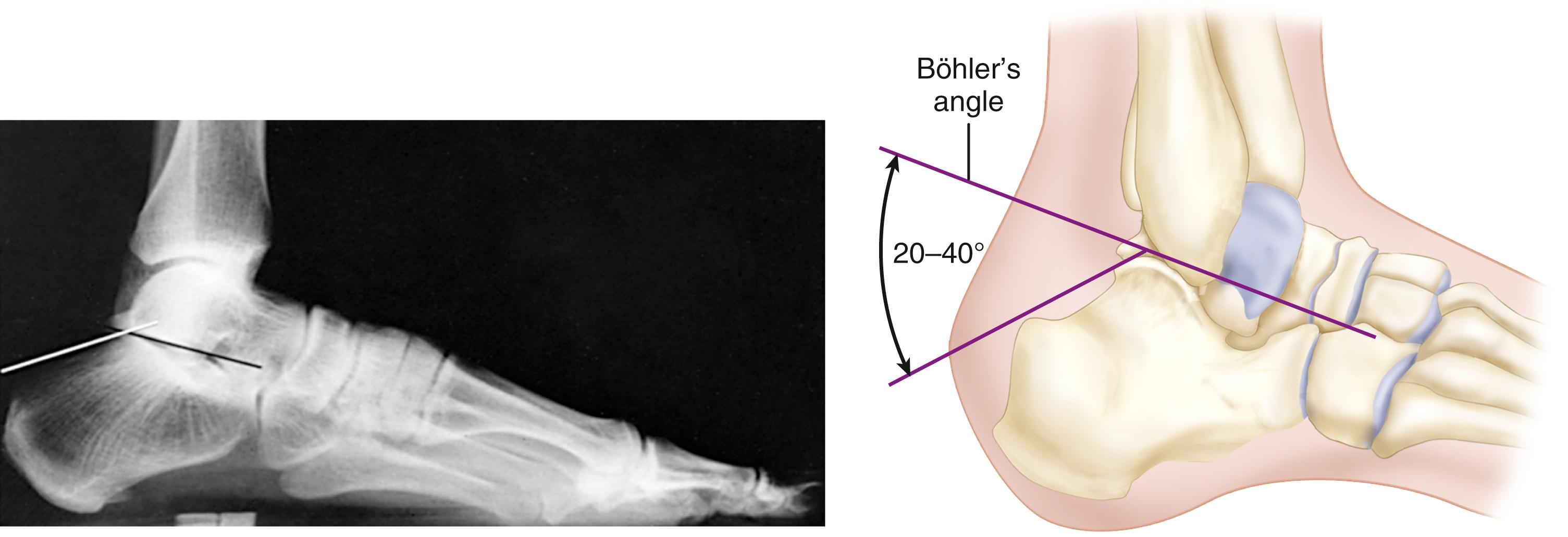
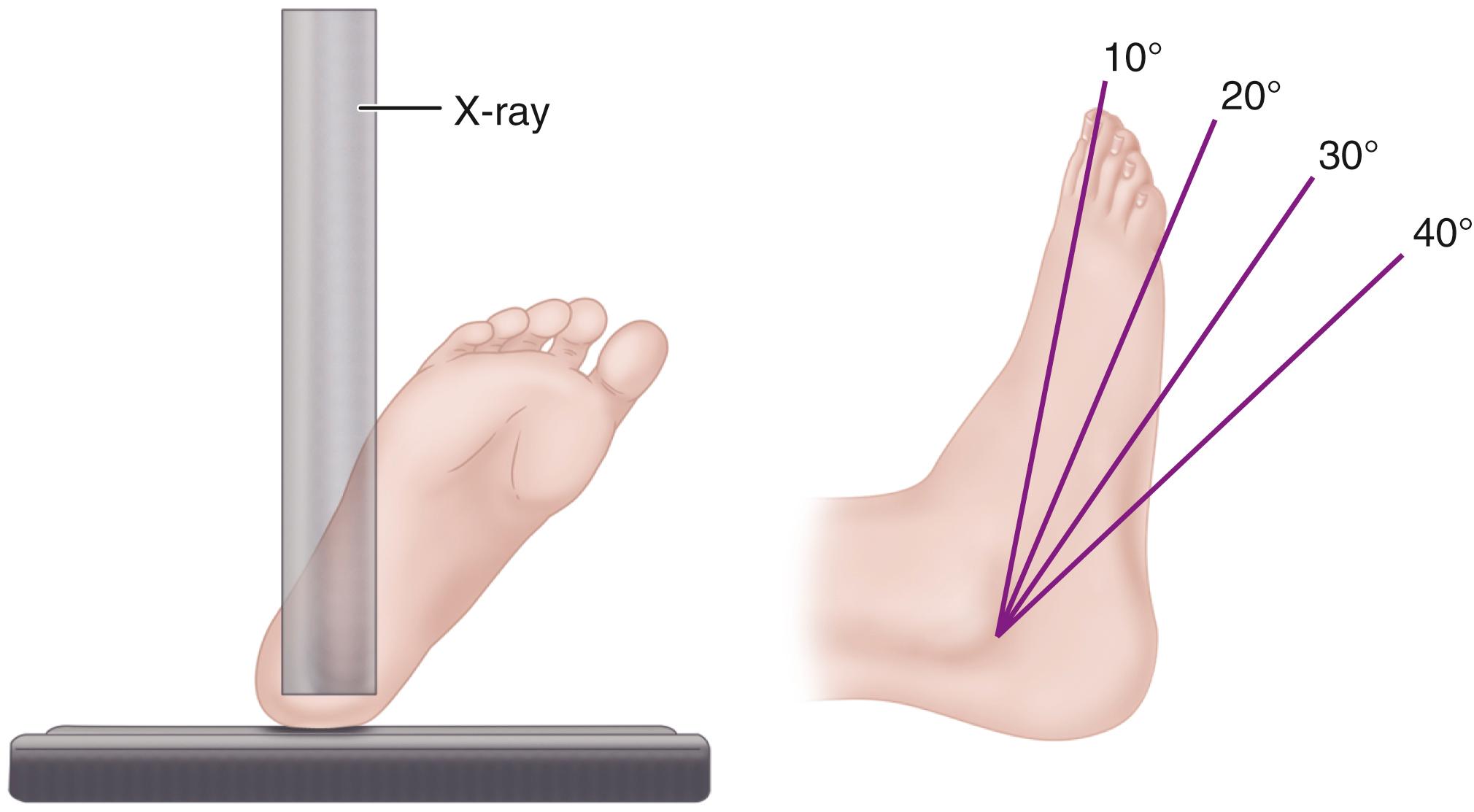
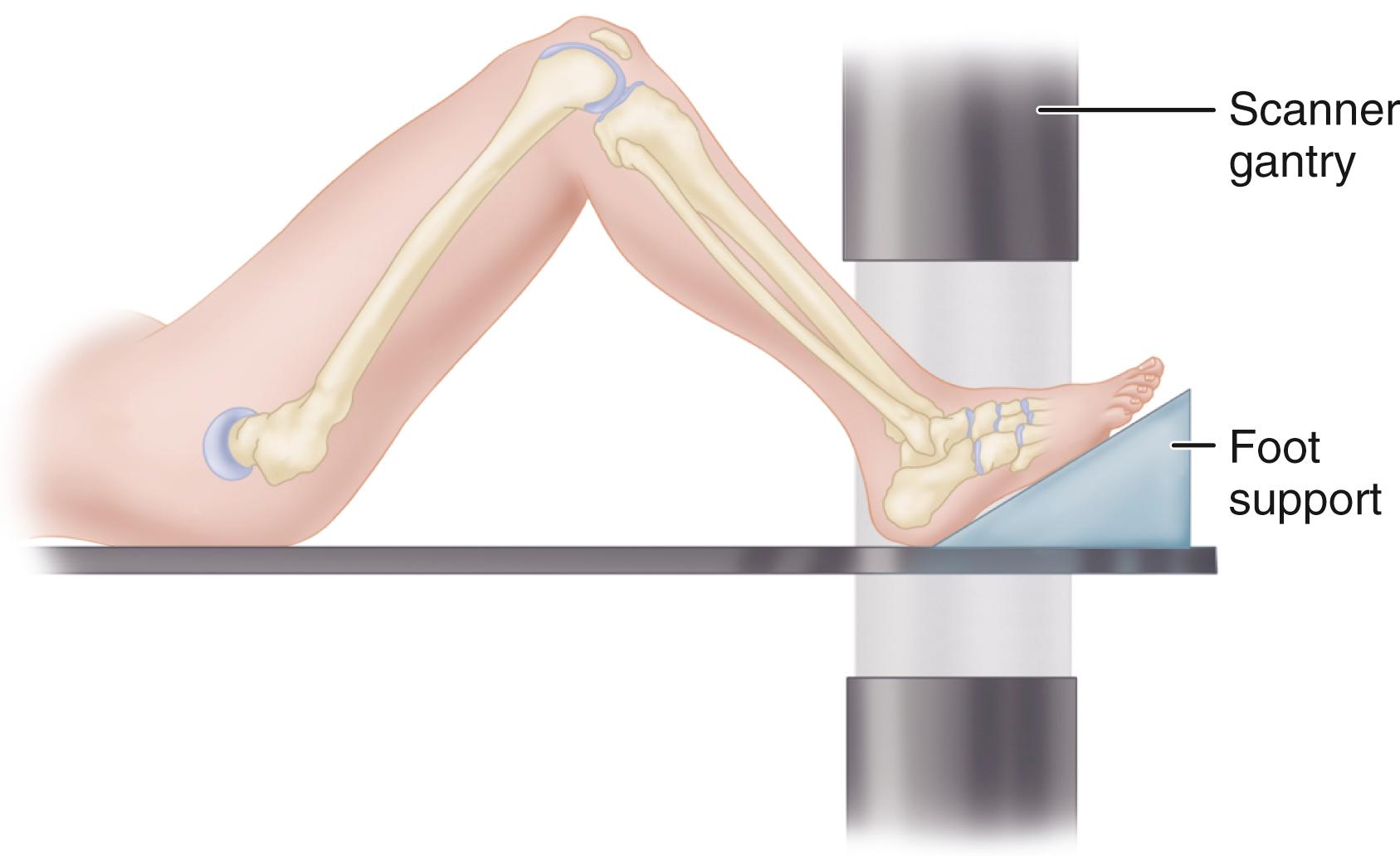
With increasing use of CT, more complex classification systems have been developed for these fractures, which have been shown to have prognostic value in the treatment of these injuries. Although the Essex-Lopresti system has been used for many years and is useful in describing the location of the secondary fracture line, it does not describe the overall energy absorbed by the posterior facet, shown by comminution or displaced fragments (see Fig. 89.3 ). Classification systems by Crosby and Fitzgibbons and Sanders have become more widely accepted in evaluation of these fractures ( Fig. 89.7 ). Both classifications are based on CT scans and describe comminution and displacement of the posterior facet. The advantage of the Sanders classification is its precision regarding the location and number of fracture lines through the posterior facet. The Sanders system uses a coronal scan through the widest portion of the posterior facet, with Roman numerals I-IV representing the number of fragments. The fragments are then classified further with letters A-C denoting the location of the fracture lines from lateral to medial. Both systems lack descriptions of other important aspects of these fractures, however, including heel height and width, varus-valgus alignment, and calcaneocuboid involvement.
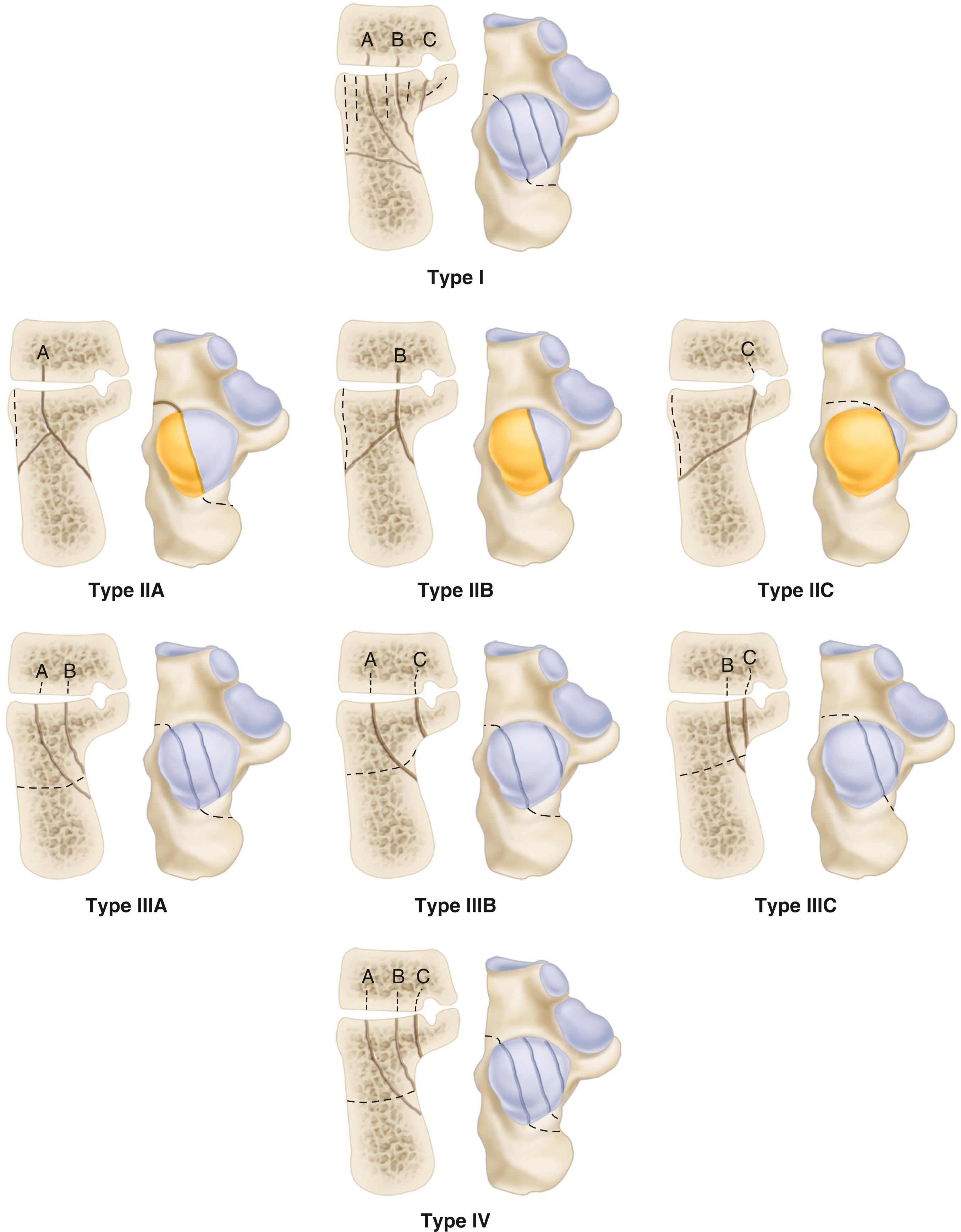
Although CT scans have become valuable in the evaluation and classification of these fractures, correlation with plain radiographs and three-dimensional reformats are helpful because traditional CT cuts may underestimate sagittal-plane rotation of the depressed fragment.
Closed treatment of intraarticular calcaneal fractures includes closed manipulation and casting, compression dressing and early mobilization, traction-fixation, manipulation as recommended by Böhler, and pin fixation as recommended by Essex-Lopresti. Manual reduction methods have been successful in some studies but are rarely used today in place of minimally invasive surgical techniques along with a manipulation.
Goals common to all types of treatment of calcaneal fractures are as follows: (1) restoration of congruency of the posterior facet of the subtalar joint, (2) restoration of the height of the calcaneus (Böhler’s angle), (3) reduction of the width of the calcaneus, (4) decompression of the subfibular space available for the peroneal tendons, (5) realignment of the tuberosity into a valgus position, and (6) reduction of the calcaneocuboid joint if fractured. Factors to be considered in formulating a treatment plan include the following.
Most injuries occur in patients younger than the physiologic age of 50 to 55 years. Consideration for operative intervention to restore calcaneal height, alignment, and articular reduction in young patients should be strongly considered. Good results can be obtained with operative treatment of older patients with calcaneal fractures with appropriate patient selection, but nonoperative treatment is advised in patients with severe osteopenia, those with limited ambulatory abilities, and those with significant medical comorbidities.
An insensate limb caused by either trauma (sciatic or tibial nerve disruption) or disease (diabetes or other neuropathy) is a strong relative contraindication to open treatment. Patients with limited ambulation because of other medical conditions likewise should be treated conservatively. Tobacco use has been shown to increase complication rates with operative intervention; however, some surgeons consider this only a contraindication to an extensile lateral approach and favor less invasive techniques in this setting.
Sanders types III and IV fractures sustained a significantly higher amount of energy than lesser types, and Park et al. showed that a Sanders type IV is the best predictor of compartment syndrome after a fracture of the calcaneus. Concurrent pathologies such as soft-tissue injuries and calcaneocuboid joint involvement are common, while the articular surface, calcaneal bone morphology, and shape are more disrupted than in lesser types. It would follow that higher Sanders types III and IV injuries have poorer outcomes than Sanders types I and II injuries with both operative and nonoperative interventions. Sanders type I or nondisplaced fractures should be treated by a closed method. Type II and type III fractures can be treated with open reduction in consideration with other patient characteristics. Type IV fractures can be treated conservatively or operatively. Long-term studies have shown that type IV injuries are more likely to go on to subtalar arthrodesis in the future. In type IV fractures, consideration should be given to minimally invasive techniques to restore the calcaneal architecture for later subtalar arthrodesis or primary subtalar arthrodesis in experienced hands.
Basic open-fracture care principles apply to calcaneal fractures. Most open injuries are caused by penetration of the sustentacular spike through the plantar medial aspect of the heel. These fractures must be treated aggressively with debridement and irrigation with strong consideration of external or limited internal fixation. There is a significant rate of deep infection in patients with open calcaneal fractures, as high as 39%, occasionally necessitating amputation.
Because of the increased complication rates seen with open calcaneal fractures, a treatment algorithm has been developed to minimize wound problems and subsequent infection. All injuries should undergo the usual care for open fractures, including antibiotics and urgent irrigation and debridement, with subsequent serial irrigation and debridements until the wound is clean. According to this protocol, all patients with lateral wounds should have open reduction through the open wound and percutaneous fixation. Open calcaneal fractures with a medial wound should have the same treatment if the wound is larger than 4 cm, cannot be closed, or is not stable after 7 to 10 days. Otherwise, open calcaneal fractures with medial wounds that are less than 4 cm with closeable, stable wounds can be treated with standard open reduction and internal fixation (ORIF) as done for closed fractures once the soft-tissue swelling subsides. This approach can decrease infection and improve outcomes. Mehta et al. reported a 7% deep infection rate using a similar approach with initial percutaneous provisional fixation and delay of definitive fixation through an extensile lateral approach for an average of 18 days (range, 10 to 28 days) for patients with open types II and IIIA medial wounds.
For open reduction techniques, patients either are operated on within the first 12 to 24 hours or, more commonly, surgery is delayed 10 to 14 days to allow soft-tissue swelling to resolve enough for the skin to wrinkle. Minimally invasive techniques are more appropriate options closer to the time of injury. Percutaneous techniques can be used as soon as the patient is medically stable, while the window for sinus tarsi approaches to fixation is within the first 10 to 14 days. After this period, restoration of the calcaneal architecture can be more difficult without extensile approaches. If the soft tissues are not suitable for fixation, a bulky Jones dressing is applied, and the foot is elevated and iced. The foot is checked before surgery to ensure that no fracture blebs are present and that swelling has started to resolve. After 3 weeks, open reduction becomes more difficult, but it is possible up to 4 to 5 weeks.
The extensile lateral technique has traditionally been the gold-standard approach among foot and ankle surgeons and traumatologists. Advantages include wide exposure of the calcaneus, allowing easier access to facet fragments, ability to decompress the lateral wall, exposure of the calcaneocuboid joint, and sufficient area laterally for plate fixation. Disadvantages include injury to the blood supply of the lateral flap and difficulty with assessment of reduction of the medial wall. More soft-tissue dissection is required, and a higher incidence of wound problems occur with this exposure. Attention to fundamentals is required for success with this approach, including careful soft-tissue handling, mobilization, and anatomic restoration of the posterior facet; adequate mobilization and reduction of the tuberosity fragment through the primary fracture line; and stabilization with plates and/or screws.
Multiple orthopaedic manufacturers produce plates specifically for use with extensile lateral techniques. Plates with locking options are popular for this fracture, although it is important to note that cortical screws will allow compression of the plate to the bone and narrowing of the widened heel. A disadvantage of a plate is its increased thickness and the possibility of a subsequent painful implant that requires removal or may block fixation for a later subtalar arthrodesis.
If a large defect remains after elevation of the posterior facet, some surgeons recommend the use of autogenous iliac crest bone graft, allograft, or bone substitutes; however, if internal fixation is secure and the fracture is stable, the defect may be accepted. No significant difference has been found in the maintenance of reduction or subsequent settling of the fracture between fixation with or without bone graft, and good results have been reported with ORIF without the use of bone graft. In a cadaver study, specimens with calcium phosphate bone cement injected into the osseous defect had decreased deformation to cyclical loading when compared with specimens with bone graft. The use of bone graft substitutes may allow patients to bear weight earlier, without loss of reduction and with similar outcomes to those in patients treated with bone graft.
(Benirschke and Sangeorzan)
Administer preoperative antibiotics and apply a tourniquet.
Place the patient in a true lateral position on a beanbag or with bolsters and use the lateral approach.
Carry the incision directly down to the periosteum of the lateral wall with no blunt soft-tissue dissection in the midportion of the wound. The sural nerve may cross the incision at its proximal and its distal end, so soft-tissue dissection should be done in these areas to avoid cutting the nerve ( Fig. 89.8A ).
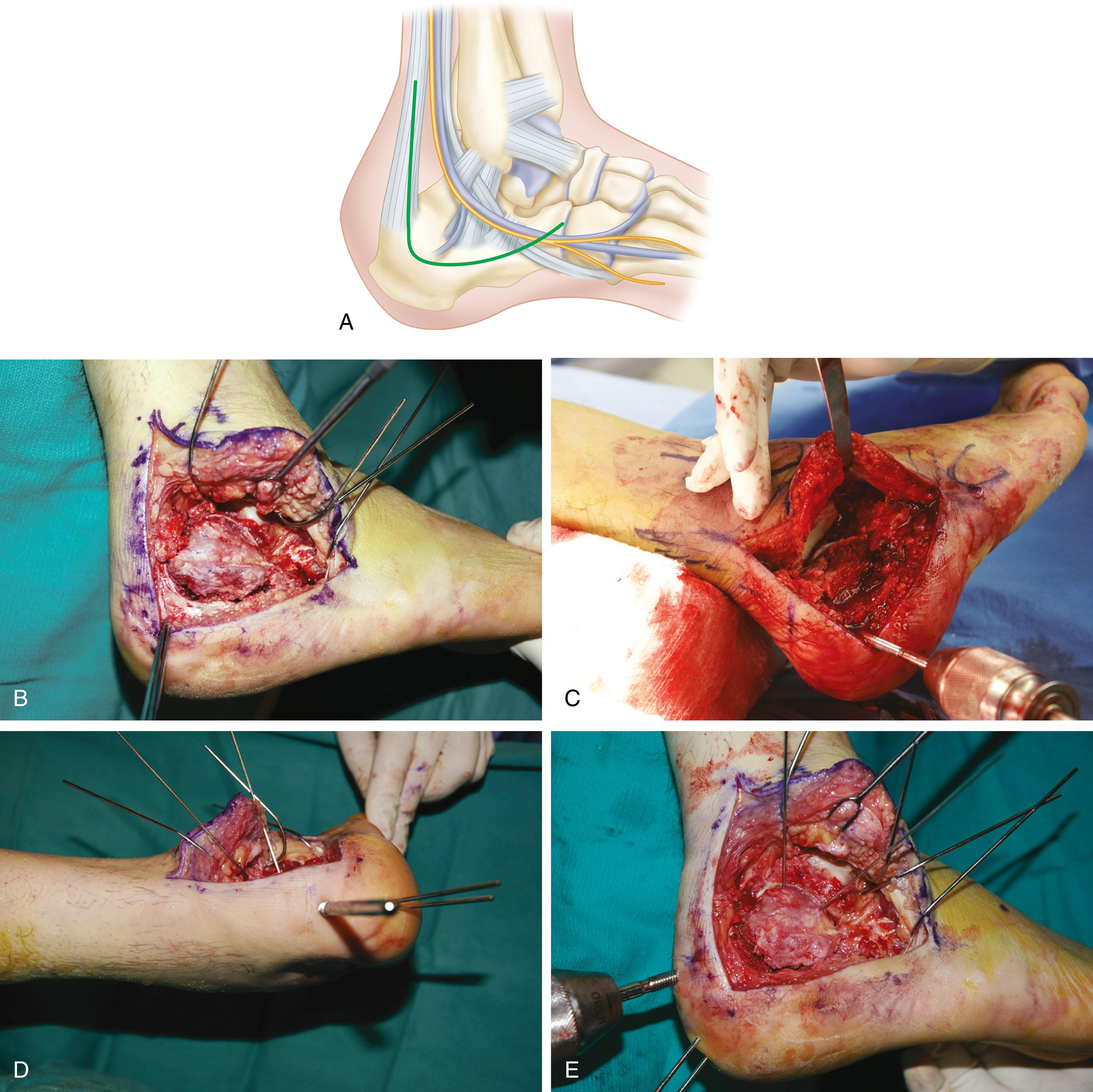
Gently retract the flap while performing subperiosteal dissection along the lateral wall. It is essential to follow the contours of the blown-out lateral wall and not stray into the soft tissues to avoid damage to the peroneal tendons. These tendons should be contained in the flap. Elevate the entire flap in one piece and hold it out of the way with a Kirschner wire placed longitudinally into the fibula, one from lateral to medial in the talus, and one into the cuboid. Bend these wires back to retract the flap, which does not need to be touched again for the remainder of the procedure ( Fig. 89.8B ).
Expose the entire lateral wall of the calcaneus distally to the calcaneocuboid joint.
Carry the dissection above and below the peroneal tendons at the level of the calcaneocuboid joint if necessary. This extensile lateral approach exposes the lateral wall of the calcaneocuboid joint and posterior facet. Reduction of the tuber-sustentacular fragment is done indirectly.
When the exposure is completed, remove the lateral wall and place it in a secure place on the back table for later replacement because this fragment blocks direct observation of the posterior facet. Do not reduce the posterior facet immediately because room for the piece must first be created.
When a fracture line separates the anterior process from the sustentacular fragment, reduce this part first to allow better exposure of the relationship between the medial part containing the sustentacular fragment and the lateral part with the posterior facet and tuberosity ( Fig. 89.8C ).
Reduce the tuberosity to the sustentacular fragment with manipulation of a large threaded Steinmann pin placed into the tuberosity fragment from either lateral to medial or directed posteriorly to correct the varus and loss of height and length; perform a provisional fixation using axially directed Kirschner wires introduced from the heel into the sustentacular fragment ( Fig. 89.8D ). A large cannulated screw can be placed to continue to hold the tuberosity out of varus.
With the bone now out to length from these two reduction maneuvers, turn attention to the depression of the posterior facet, reducing it to the intact medial piece and holding it with provisional fixation ( Fig. 89.8E ).
Obtain intraoperative radiographs to assess overall reduction.
A large defect often remains in the substance of the calcaneus beneath the reduced posterior facet. If good stability of the fracture and secure internal fixation are obtained, this defect can be accepted or bone graft or bone cement can be used to fill the void.
Reduce the lateral wall along the outer edge of the posterior facet and perform fixation, which should take advantage of the known anatomy. The thickened bone in the thalamic portion, which supports the posterior facet, provides the most reliable fixation in most instances.
Insert small cortical lag screws (2.4 or 2.7 mm) into the sustentacular fragment to maintain the reduction of the posterior facet. A cadaver study showed that the widest safe zone for the starting point of the lag screw is 15 mm below the joint line of the posterior facet, dropping the hand 20 degrees from the perpendicular to the axis of the leg, and aiming from 6 degrees anteriorly at the most anterior starting point to 36 degrees anteriorly from the most posterior starting point to get the sustentaculum without violating the joint.
Apply a lateral plate that extends from the anterior process of the calcaneus into the most posterior aspect of the tuberosity ( Fig. 89.9A and B ). The plate helps to maintain a neutral alignment of the calcaneus. When contouring the plate, be careful not to fix the heel in varus. Obtain an intraoperative axial view to confirm neutral alignment before application of the plate. When possible, direct screws from the plate into the sustentacular fragment for maximal fixation. Place the most anterior screw into the subchondral bone supporting the calcaneocuboid articular surface. Place the most posterior screw into the thickened bone at the posterior aspect of the calcaneus.
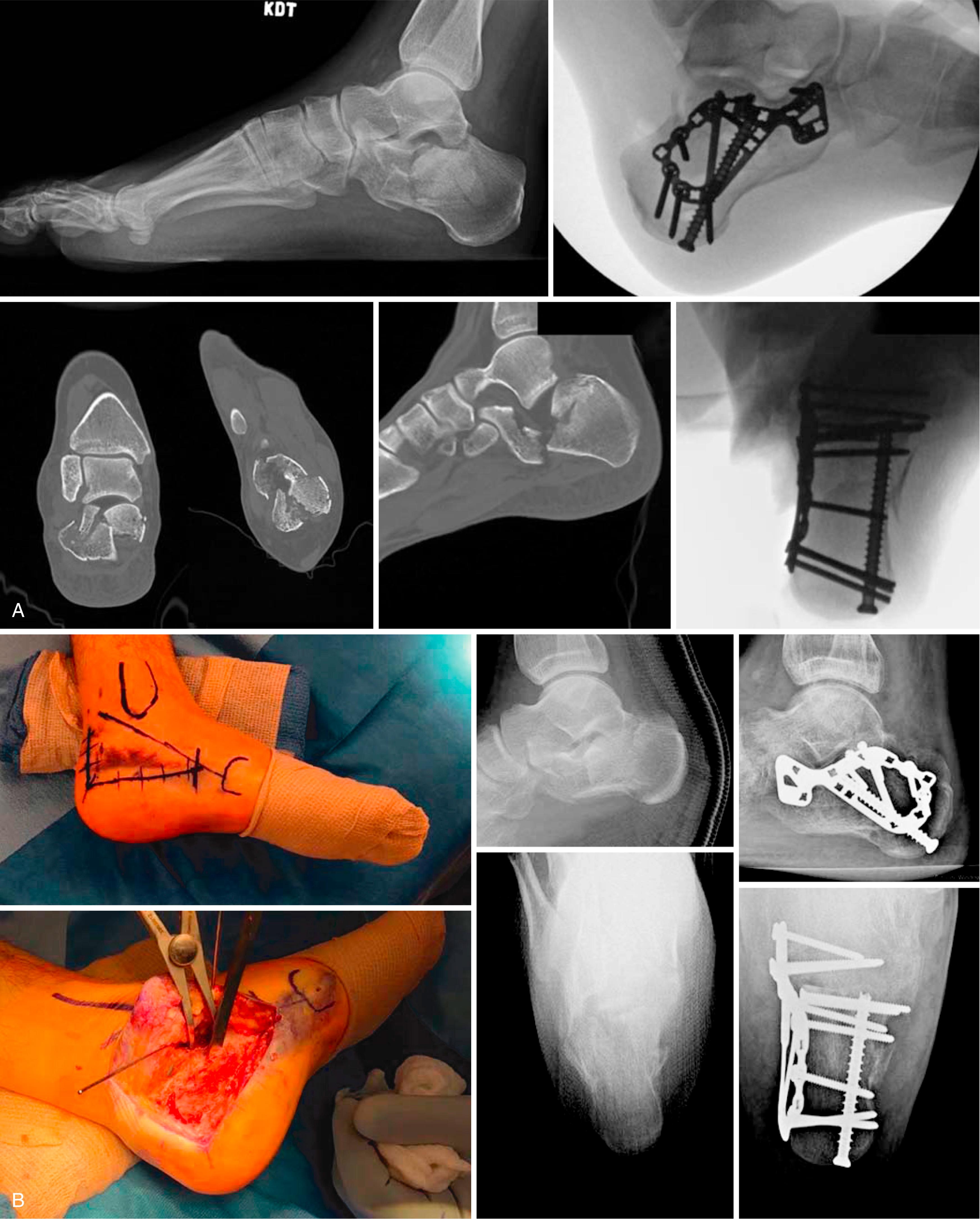
Close the flap over a deep drain if desired. It is useful to throw all of the subcutaneous absorbable sutures first and then tie to allow better access and wound edge approximation. A modified Donati-Allgower technique is used for skin closure. Apply a short leg splint.
See also .
Closed suction drainage is used for 24 to 48 hours if needed. Strict icing and elevation protocols should be maintained to minimize swelling and pain. At the second postoperative week, active range of motion of the ankle and subtalar joint is instituted if the flap shows uncomplicated healing and the wound is sealed. Patients learn to draw the alphabet with the hallux of their injured limb or make progressively larger circles with their feet. Protection is provided by the use of a removable posterior splint or fracture boot. Weight bearing is instituted at 10 to 12 weeks, extensive physical therapy is started, and implants can be removed if the injury is symptomatic at 1 year.
Carry out ORIF of the calcaneus as described in Technique 89.1 ( Fig. 89.10 ).
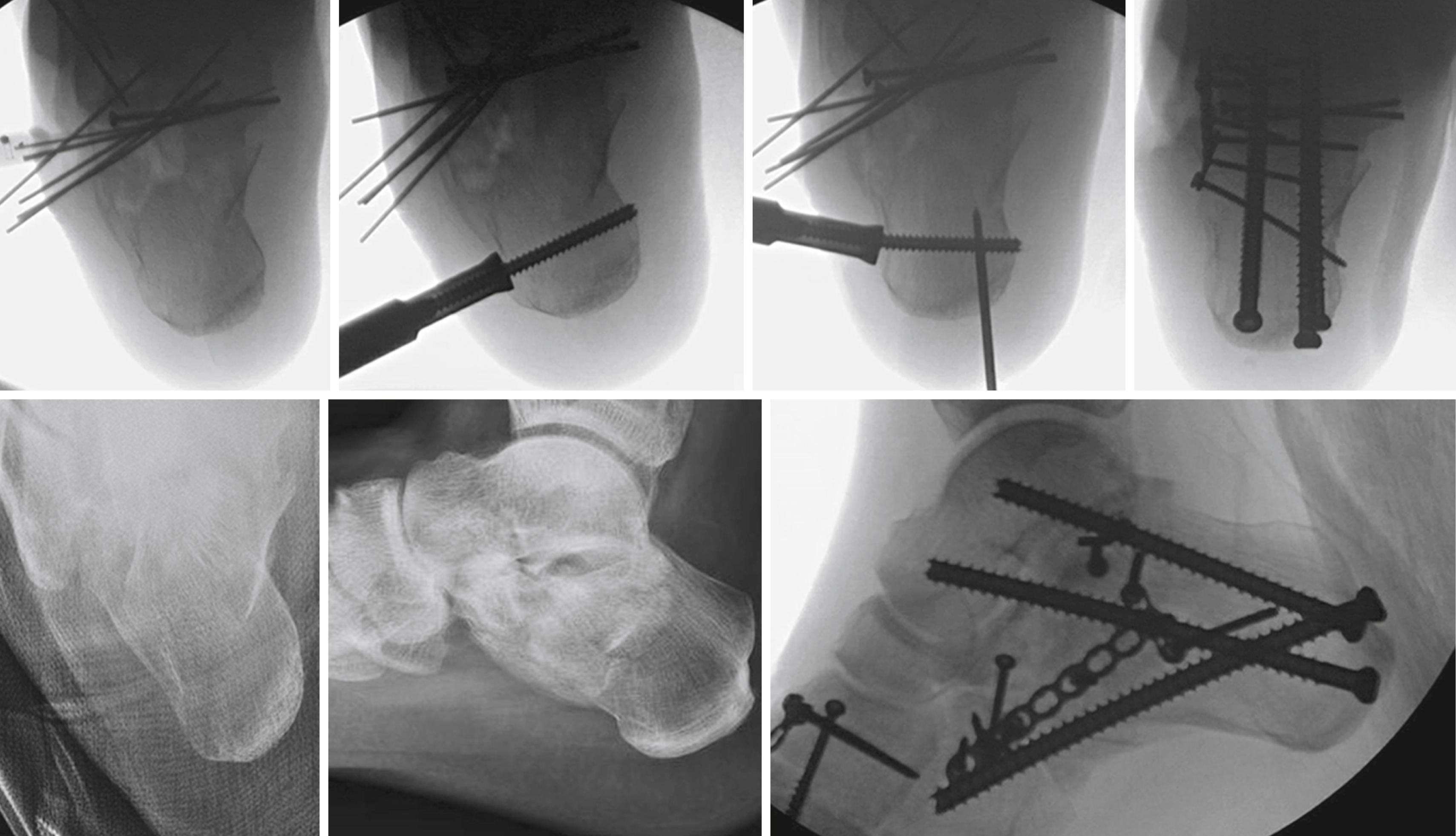
Major bone voids in the posterior side of the calcaneus may require tricortical iliac crest bone graft to restore the normal orientation and height of the calcaneus.
After internal fixation, use a burr to remove the cartilage and subchondral bone from the posterior facet of the calcaneus and posterior facet of the talus.
Use extensive autogenous iliac crest bone graft to fill the defect.
Denude the lateral aspect of the talus to obtain an intraarticular and an extraarticular arthrodesis.
Fix the arthrodesis with two fully threaded, 6.5-mm cancellous screws ( Fig. 89.10 ).
The drain, if used, is removed on the first postoperative day, and the sutures are removed at 2 to 3 weeks. A short leg cast or fracture boot is worn until evidence of union is apparent, generally between 10 and 12 weeks. A prefabricated walking brace is applied, and the patient is gradually allowed to return to full activities.
The sinus tarsi approach has become more widely used and can avoid some of the wound complications associated with the extensile lateral approach. There is wide variation in the literature as to what size incision is used in a sinus tarsi approach, ranging from 1 to 2 cm, centered on the posterior facet ( Fig. 89.11 ) for exposure from the posterior fibula to the anterior process of the calcaneus as described by Kocher. Advantages of this approach include direct visualization of the posterior facet (which may be difficult with the extensile lateral approach), lower wound complications, and use of the same incision that would be used for an arthrodesis in the future. Disadvantages of this approach are that lateral wall decompression can be more difficult and reduction of the tuberosity fragment is indirect. In most cases, the lateral approach provides enough exposure for fracture fixation, although this can be combined with a medial approach. The medial approach allows direct reduction of the sustentacular fragment, which may not be “constant” in 42% of patients, according to one study. The medial approach requires careful exposure and mobilization of the medial neurovascular bundle. A variety of sinus tarsi–specific plates have been developed; however, Pitts et al. showed no significant difference in outcomes with plate versus screw-only fixation constructs.
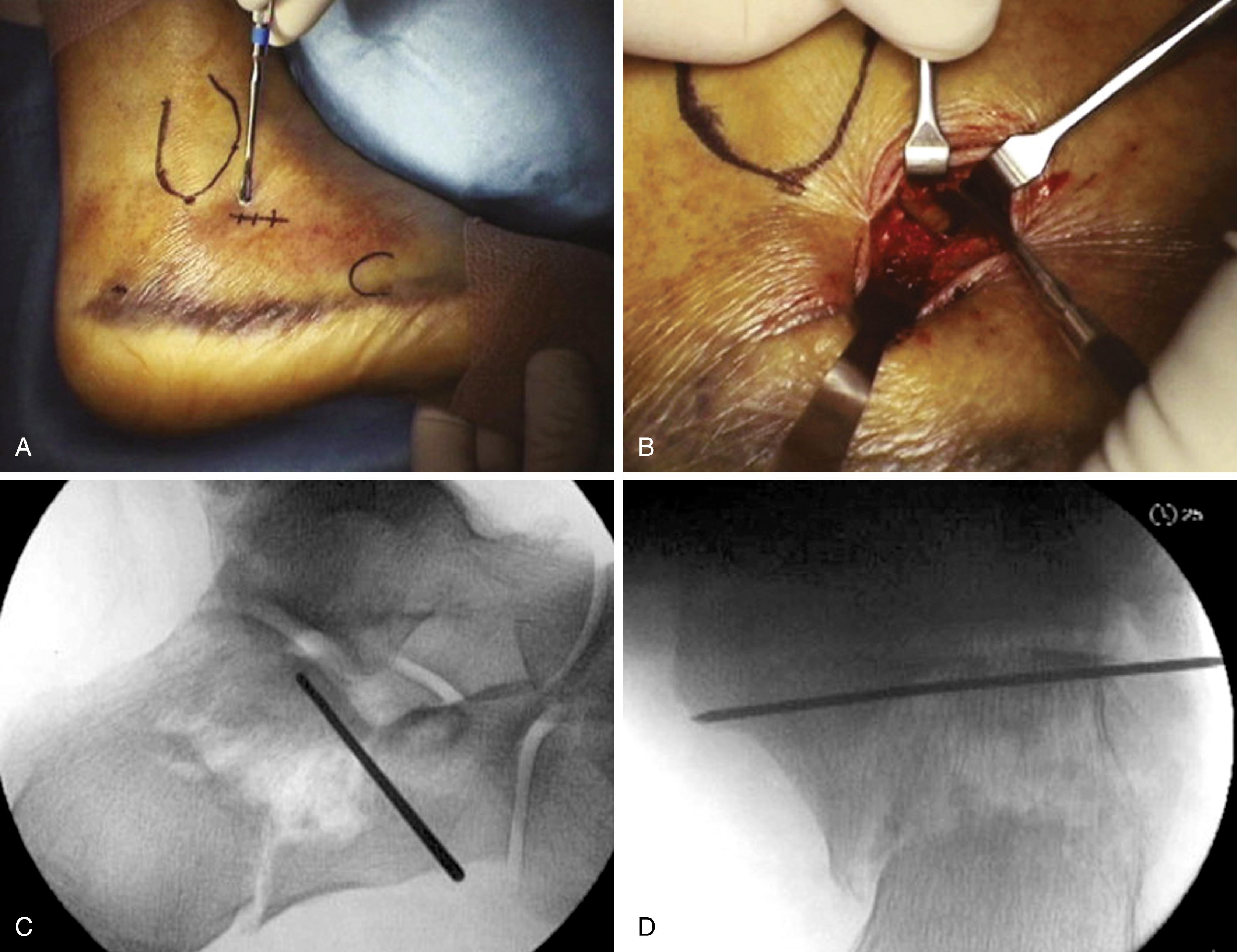
Two incisions, one medial and one lateral, can be used, although usually the lateral incision provides enough exposure to reduce the major fragments ( Fig. 89.12A to C ).
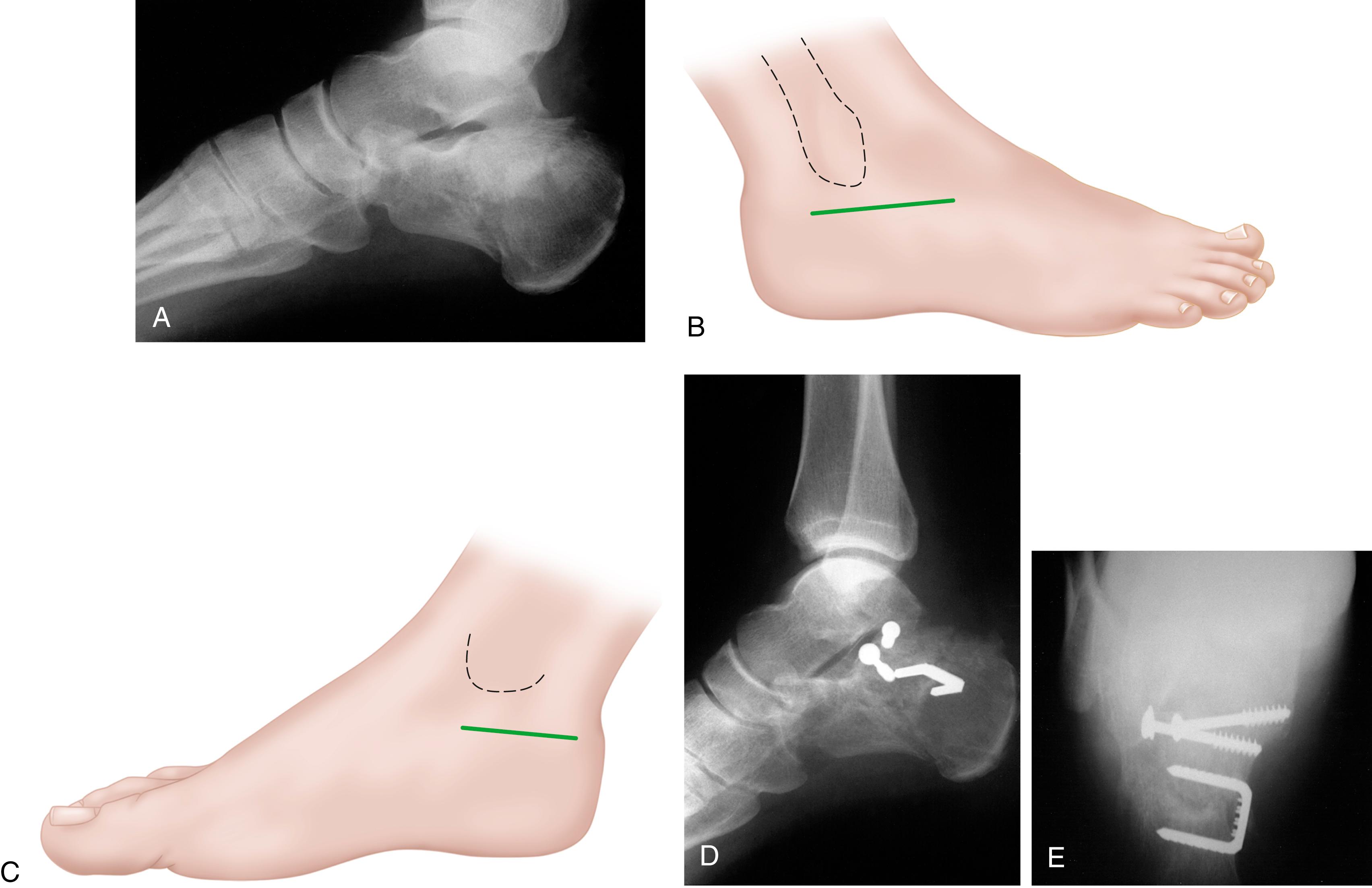
Place the patient in the lateral position on a beanbag or bolsters. If the supine position is chosen, place a large bump beneath the ipsilateral buttock. Apply a tourniquet. Place the patient in a mildly inclined Trendelenburg position and rest the foot on towels or sheets, which at varying times in the procedure allow the foot to hang freely without support when the towels are moved proximal to the ankle joint.
Make the lateral incision along a line from the tip of the fibula toward the base of the fourth metatarsal centered on the posterior facet and as long as needed to allow visualization of the joint reduction.
Identify the sural nerve in the posterior portion of the incision; it usually lies in a small amount of fat just anterior to the small saphenous vein and overlying the combined sheath of the peroneal tendons. Dissect it distally. Try to preserve both main branches, but if exposure of the lateral aspect of the sinus tarsi and calcaneocuboid joint is incomplete, the medial branch, which usually joins with the lateralmost branch of the superficial peroneal nerve, can be sacrificed without causing significant numbness at the fourth web.
When the sural nerve and small saphenous vein are retracted, open the inferior peroneal retinaculum on its anterior border where it meets the stem of the inferior extensor retinaculum to expose the anterolateral ridge of the anterior third of the calcaneus, which is the most lateral border of the sinus tarsi.
Reflect the origin of the extensor digitorum brevis distally to expose the calcaneocuboid joint. Elevate the extensor digitorum brevis only as much as necessary to expose the calcaneocuboid joint.
Expose the lateral wall of the calcaneus by sharp dissection or with a thin osteotome or periosteal elevator. A small Hohmann retractor can be placed under the peroneal tendons to retract them posteriorly. This is the “door” to the anterior two thirds of the lateral surface of the calcaneus. Stay in this plane with the foot held in valgus and equinus. The lateral wall is thin and frequently comminuted. Distally, the fracture may enter the calcaneocuboid joint.
Take care to remain lateral to the lateral wall. With lateral wall blowout, it is easy to enter medially to the lateral wall, which will prevent proper placement of a lateral plate.
A large threaded Steinmann pin can be placed into the posterior tuberosity for traction and manipulation of the large tuberosity fragment (see Fig. 89.10 ).
Remove any further hematoma and inspect the posterior facet. If inspection is difficult, place a lamina spreader into the depths of the sinus tarsi, pressing up on the neck of the talus and down on the anterior portion of the calcaneus to give a better view of the posterior facet. This is a pivotal point in the procedure, at which time it should be possible to form a good mental image of the fractures through the posterior facet (usually sagittal) and transversely across the junction of the posterior facet articular surface and the proximal border of the sinus tarsi. This latter fracture frequently communicates medially with the oblique fracture that splits off the large anteromedial sustentacular fragment.
Insert a Cobb elevator into the primary fracture line to mobilize the fragments, and use the Steinmann pin to manipulate the tuberosity plantarly and posteriorly to regain height and length, and with a valgus moment to correct any varus. Insert provisional fixation with a guidewire for a 5.5-mm or 6.5-mm cannulated screw from the tuberosity into the sustentaculum.
If a satisfactory medial wall reduction cannot be obtained with manipulation of the tuberosity with the Steinmann pin, a medial approach should be considered.
For the medial incision, tilt the operating table laterally, flex the knee, and abduct the hip. Dorsiflex the foot to 90 degrees at the ankle joint.
Palpate the most prominent portion of the subcutaneous edge of the tarsal navicular and 1 cm anterior to this begin an incision straight posteriorly that crosses the sustentaculum tali. If the sustentaculum cannot be palpated because of swelling, have the incision cross a point 2 cm distal to the subcutaneous tip of the medial malleolus. Continue the incision posteriorly to 1.5 to 2.0 cm anterior to the Achilles tendon.
Identify the anterior (distal) and posterior (proximal) borders of the flexor retinaculum (laciniate ligament) that runs from the medial malleolus obliquely plantarward and posteriorly to the posterosuperior border of the calcaneus. The superficial fascia of the leg and foot is continuous with the flexor retinaculum, and this also must be opened the entire length of the incision.
Dissect the retinaculum anteriorly 1 cm and plantarward to the upper border of the abductor hallucis.
Identify the neurovascular bundle at the posterior or proximal edge of the flexor retinaculum. Bluntly delineate the posterior aspect of the bundle, ensuring that the lateral plantar artery, vein, and nerve are included in the dissection.
Pass a Penrose drain around the bundle and gently retract it anteriorly for further exposure of the posterior border of the bundle. Dissect this until it is lost beneath the abductor hallucis.
Retract the posterior tibial neurovascular bundle anteriorly (usually one or more medial calcaneal branches must be retracted posteriorly) and expose the medial surface of the calcaneus by lifting the abductor hallucis and flexor accessory muscles off the calcaneus with a periosteal elevator.
Palpate the sustentaculum tali of the calcaneus and clear all soft tissues from the medial surface of the calcaneus from the sustentaculum to the medial ridge of the calcaneal tuberosity.
The fracture lines delineating the anteromedial and tuberosity fragments should come into view.
Pass an instrument or finger over the tuberosity fragment and communicate with the lateral wound. Using an instrument or finger, pull down on the tuberosity fragment, disimpacting and dorsiflexing it while holding the ankle in equinus.
Return to the medial wall of the calcaneus and inspect the fracture lines again. The tuberosity fragment is displaced laterally and distally and must be pulled posteriorly, translated medially, and taken out of varus with help of the Steinmann pin.
Make a final evaluation of the fracture patterns and plan the fixation.
While holding the medial wall reduced manually, direct one or two pins from the posterolateral aspect of the posterior tuberosity just lateral to the Achilles tendon and direct the pins upward and medially to engage the sustentacular fragment.
Through the lateral incision, gently tap a 5- to 6-mm osteotome deep to the depressed posterior facet fragment and, holding the foot in varus for better exposure, lift the posterior facet into its proper position and pin it to the sustentacular fragment with two 0.062-inch Kirschner wires. Place these wires just below the articular surface in subchondral bone for good purchase. Pass the wires to the medial side, directed distally about 10 to 20 degrees, and locate them by palpation.
Ensure that a second sagittal fracture through the posterior facet medial to the first fracture is not overlooked because, if present, both depressed fragments need elevation and fixation. Reducing the posterior facet can leave a gap in the cancellous bone beneath the facet; bone grafting of the defect is optional.
Reduce the anteromedial and tuberosity fragments and the posterior facet; the tuber-joint angle should be within normal limits.
Place lateral to medial screws (2.4 mm or 2.7 mm) from the posterior facet into the sustentaculum in subchondral bone.
A small two-hole plate can be used medially if needed, but this is difficult if the temporary fixation pins have been placed too close together or are in the way of optimal plate placement; keep this in mind when placing the wires ( Fig. 89.13 ).

Place an additional cannulated screw from the tuberosity under the posterior facet screws acting as a kickstand. A third screw can be placed in the lateral calcaneus from the tuberosity into the anterior process to maintain length.
A variety of plates designed for the sinus tarsi approach can be used, if desired, and screws inserted subcutaneously ( Fig. 89.14 ). Use of a small 1/3 tubular plate also is an option ( Fig. 89.15 ). Fractures can also be fixed with a screws-only approach (see Fig. 89.11 ).
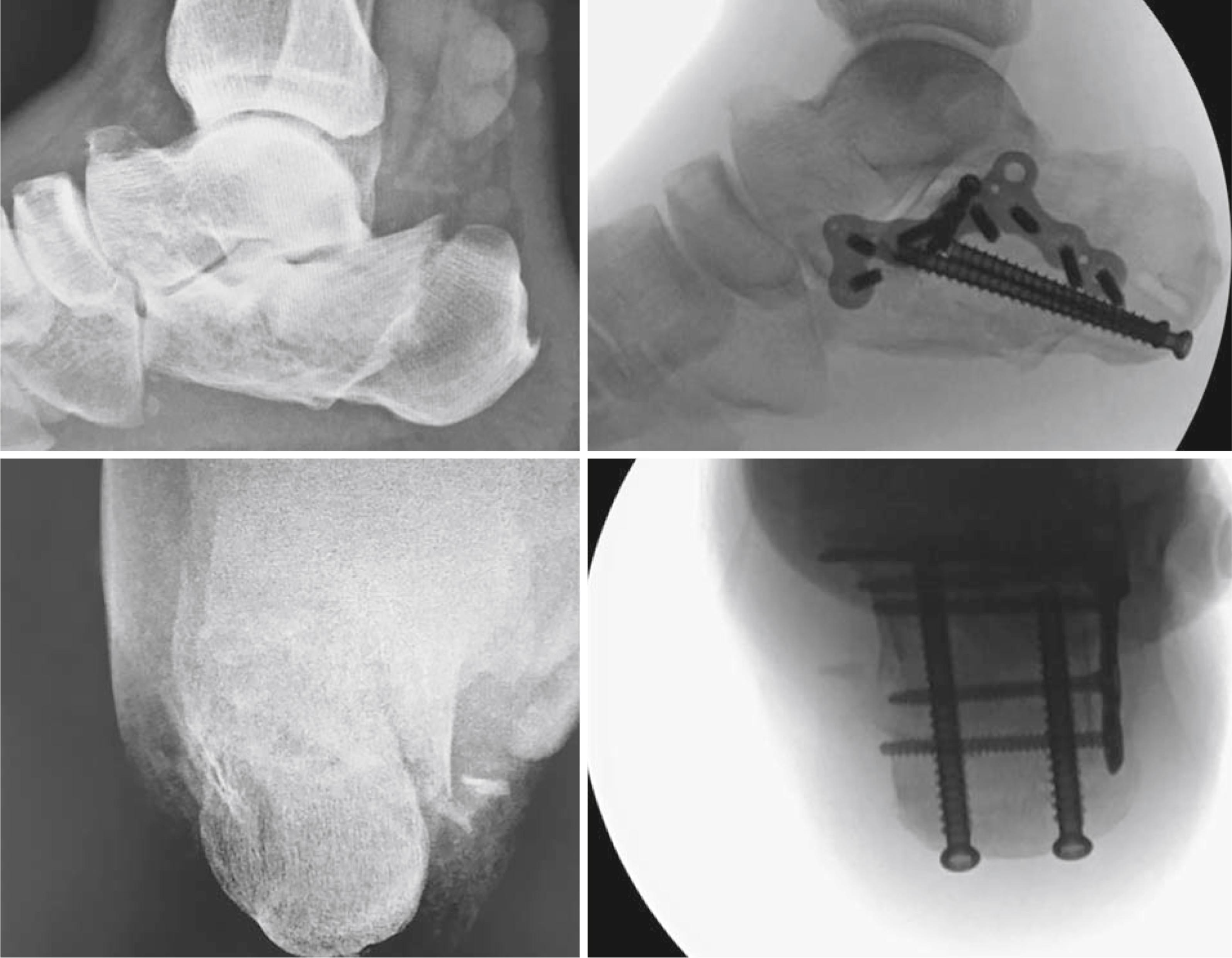
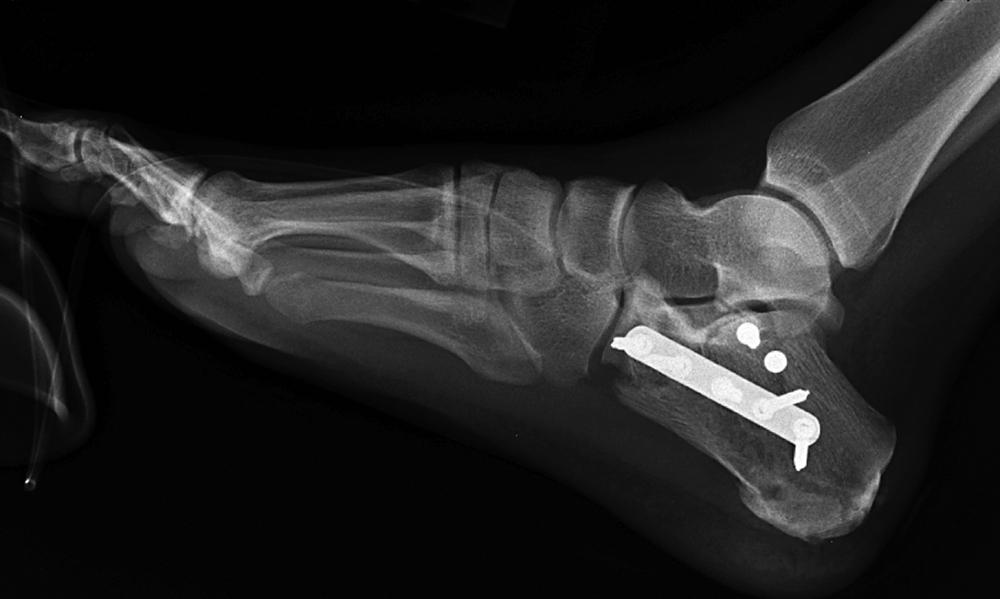
Take axial and lateral radiographs, lavage the wounds, remove the tourniquet, and close the wounds.
Wrap large, bulky gauze dressings from the toes to the tibial tuberosity and apply a short leg cast.
The extremity is elevated and iced postoperatively. At 3 weeks, the sutures are removed, and gentle range of motion is initiated. Non–weight bearing is continued until 8 to 12 weeks postoperatively, depending on bone quality and strength of fixation.
Although the previously described technique works for joint depression and tongue-type fractures, occasionally a tongue-type fracture does not involve additional fracture lines, widening of the lateral wall, or significant displacement at the primary fracture line. The tongue fracture in this case can be treated by the axial pin fixation described by Gissane, and popularized by Essex-Lopresti, who achieved satisfactory results. Tornetta reported successful outcomes with this technique in 41 patients.
A subset of patients with calcaneal fractures is prone to skin breakdown over the fracture fragment posteriorly. These tend to be patients who did not sustain the injury from a fall, who smoked, who had greater fracture displacement (although it can happen even with minimal displacement), and who were evaluated after a delay. If the threatened soft tissue is recognized early and prompt intervention is instituted, wound problems can be avoided. Otherwise, these patients may require soft-tissue coverage and may eventually require amputation. Similar soft-tissue problems can occur after tuberosity avulsion fractures unless prompt reduction is performed (see Figs. 89.31 and 89.32 ).
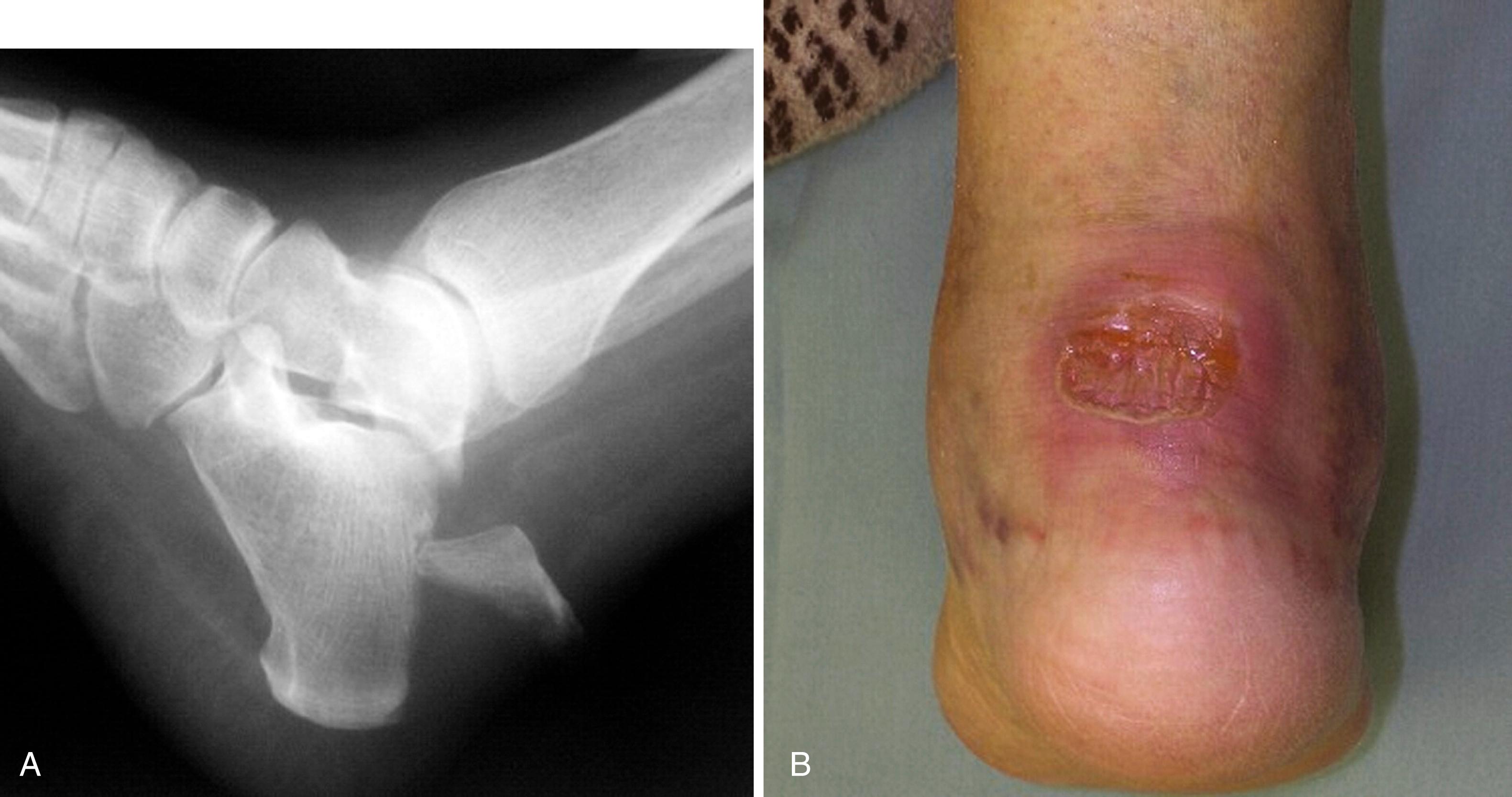
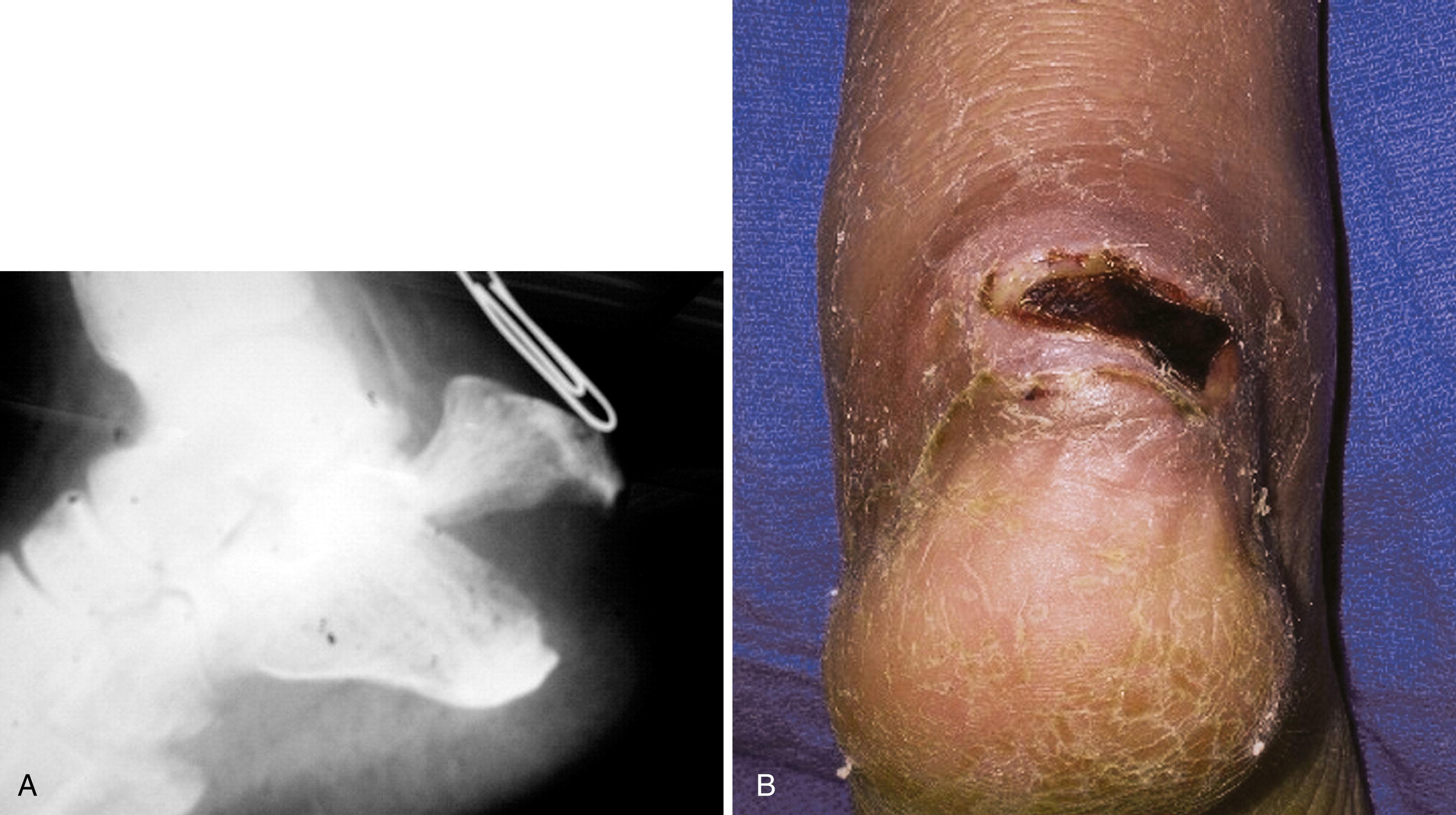
(Essex-Lopresti)
With the patient prone, make a small incision over the displaced tuberosity of the calcaneus just lateral to the attachment to the Achilles tendon.
Introduce a heavy Steinmann pin or Gissane spike into the tongue fragment in a longitudinal direction, angling slightly to the lateral side. Use radiographic or image intensifier control during the insertion of the pin and manipulation of the fracture ( Fig. 89.16A ).
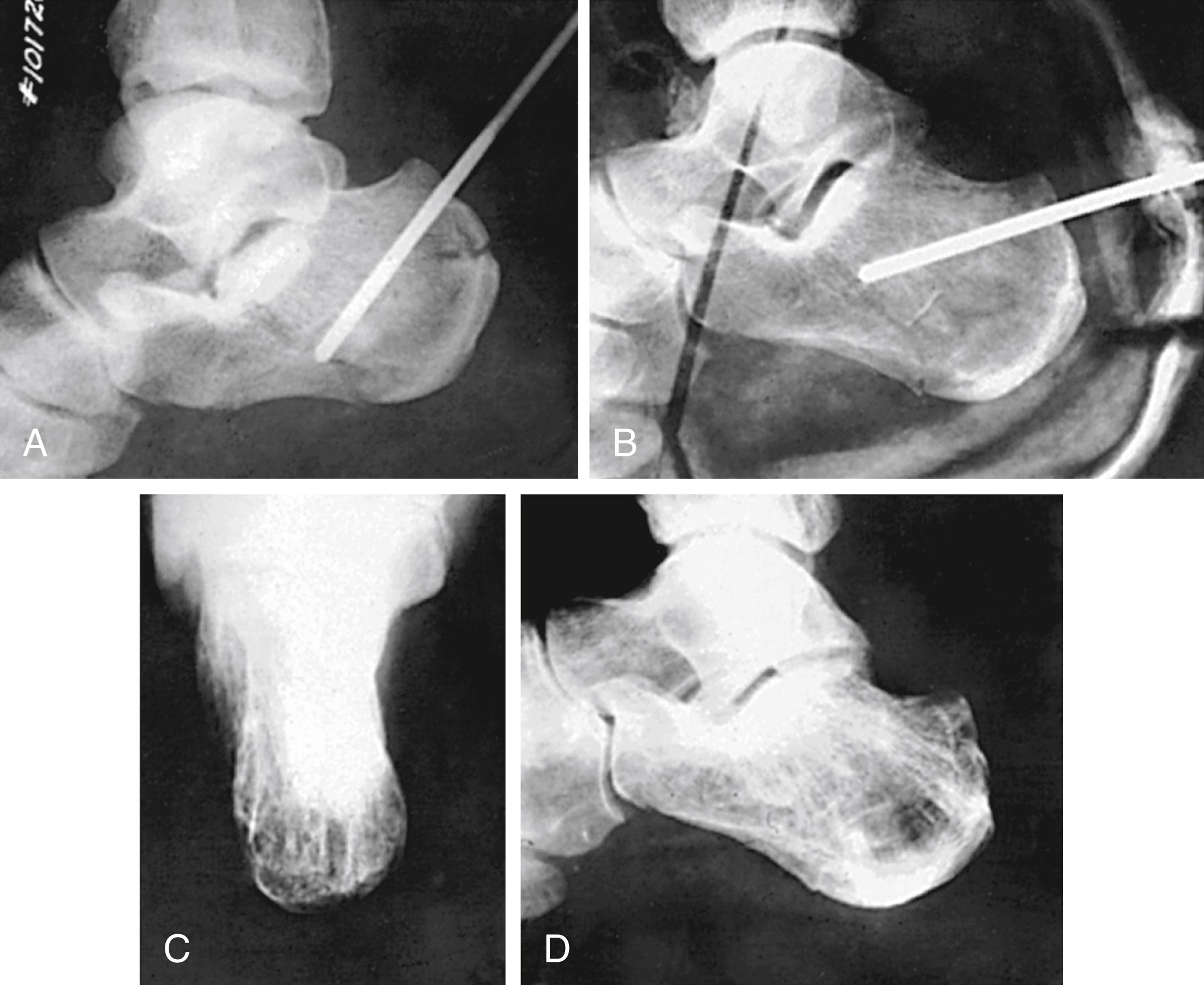
With the knee flexed, reduce the fracture by lifting upward on the pin until the knee clears the table; hold the forefoot at the level of the midtarsal joints with the opposite hand and avoid creating a cavus deformity by hyperflexing the forefoot. By this maneuver, the tongue fragment is elevated from its depressed position in the body of the calcaneus.
Reduce the spreading of the calcaneus by applying pressure on each side of the bone with the heels of the clasped hands. Clear the inferior aspect of the lateral malleolus from contact with any bulging bone fragments that may encroach on the peroneal tendons and produce chronic tenosynovitis.
Gently rock the calcaneus to settle the smaller fragments into position.
Make final radiographs to confirm the position ( Fig. 89.16B ).
Advance the pin or spike across the fracture into the anterior fragment of the calcaneus.
The foot is carefully padded, and a splint is applied, incorporating the protruding portion of the pin or spike. The initial cast and pin usually are removed at 4 to 6 weeks, and a cast is applied from the tibial tuberosity to the toes. If radiographs confirm union and reconstitution of the depressed cancellous bone beneath the elevated articular surface, weight bearing can be started 8 to 10 weeks after reduction ( Fig. 89.16C and D ).
To minimize wound complications, reduction and percutaneous fixation of calcaneal fractures have become more popular. This approach allows restoration of the basic morphology of the calcaneus and improves the articular reduction; however, it relies heavily on fluoroscopy rather than direct visualization of the joint surfaces. Experience with open fixation of calcaneal fractures is advantageous to understanding the anatomy and interpreting fluoroscopy appropriately to gain the appropriate reduction and fixation. It often is very difficult to obtain a perfect articular reduction with this technique in Sanders types III and IV fractures, although the calcaneal length and height may be restored and provide a better foundation for subtalar arthrodesis in the future. Arthroscopic evaluation may be helpful in evaluating the reduction. If this technique is chosen, it is helpful to perform the surgery as soon as feasible after the injury before the frature fragments consolidate, making reduction more difficult.
(Rodemund and Mattiassich)
Place the patient in a lateral position with a thigh tourniquet, the hip extended, knee flexed, and leg resting on a padded well leg holder ( Fig. 89.17 ). Keeping the leg holder as proximal as possible allows access to the ankle for other procedures such as a heel cord lengthening.
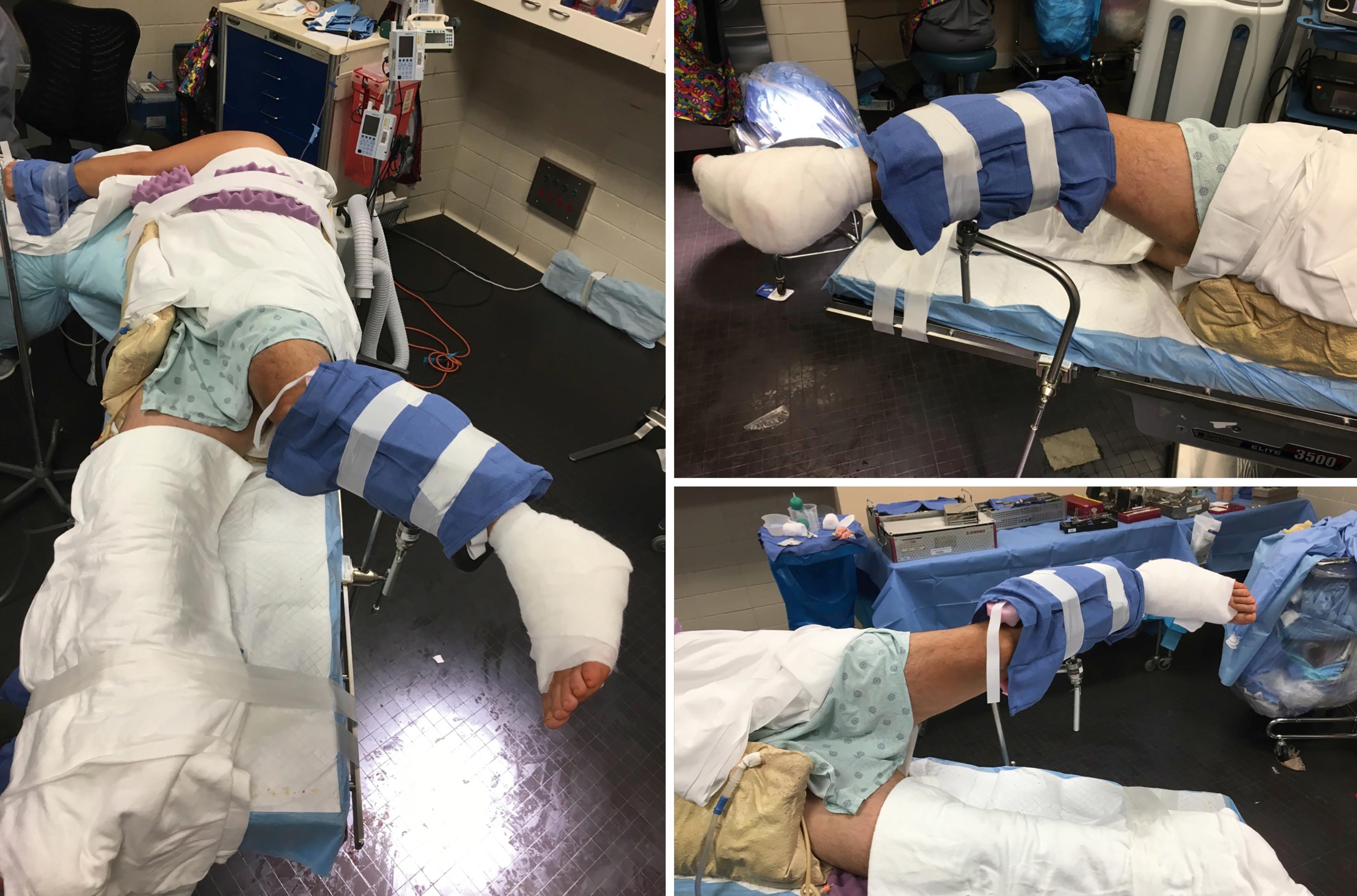
Place C-arm fluoroscopy on the operative side and angle it at 45 degrees to the operating table. This allows the procedure to be performed in the lateral radiographic view. Rolling the C-arm back allows a Broden view, while swinging through to a traditional lateral C-arm position produces a Harris axial view of the calcaneus ( Fig. 89.18 ).
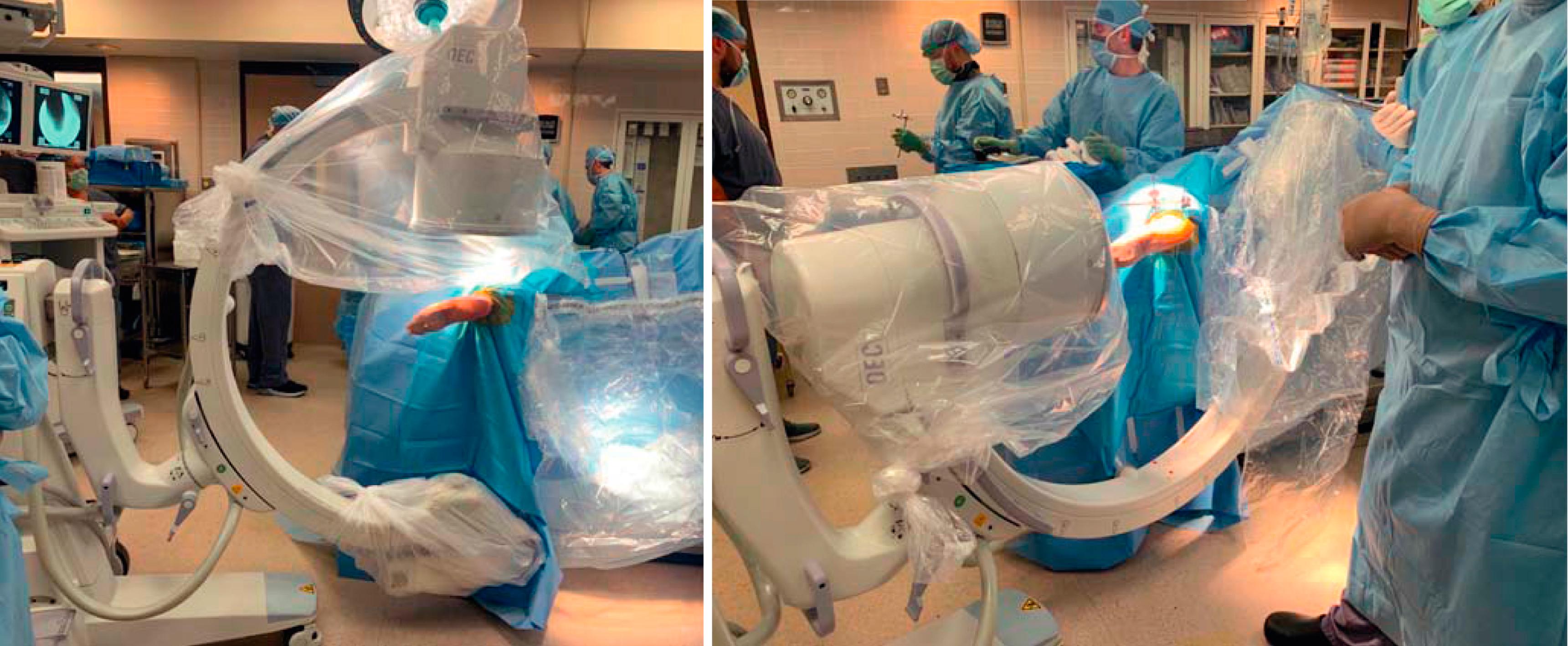
Place long 3.0-mm Kirschner wires through the talar neck and calcaneal tuberosity and affix them to dual distractors on both the medial and lateral side of the calcaneus ( Fig. 89.19 ). Take care to be perpendicular to the lateral wall of the tuberosity when inserting the Kirschner wire.
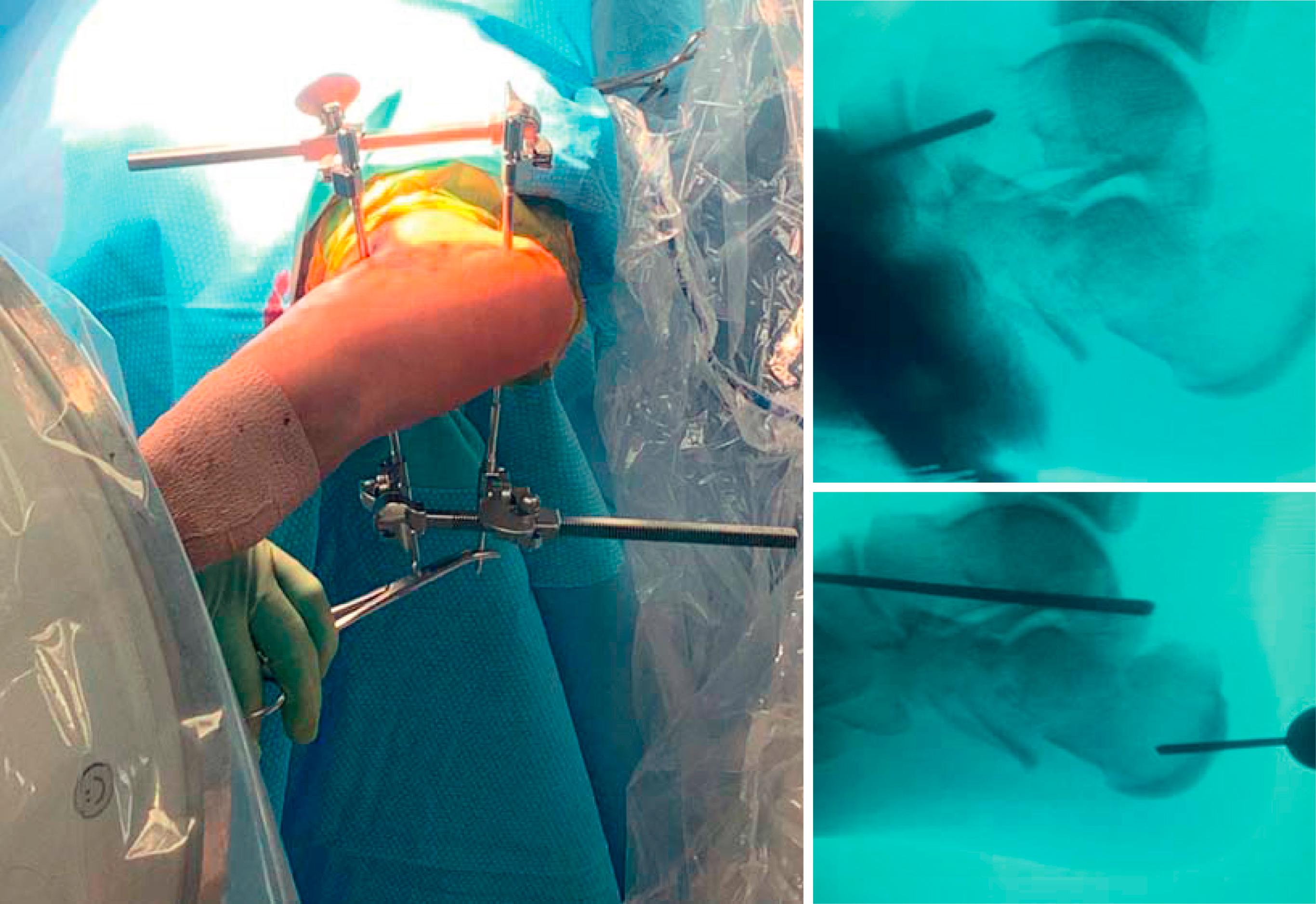
Generally, there is varus alignment to the fracture, such that the Kirschner wires will form an acute angle and not be parallel initially. With the distractors applied, the wires will become parallel and allow varus alignment to be corrected. Continued dual distraction allows restoration of the length and height of the calcaneus ( Fig. 89.20 ).
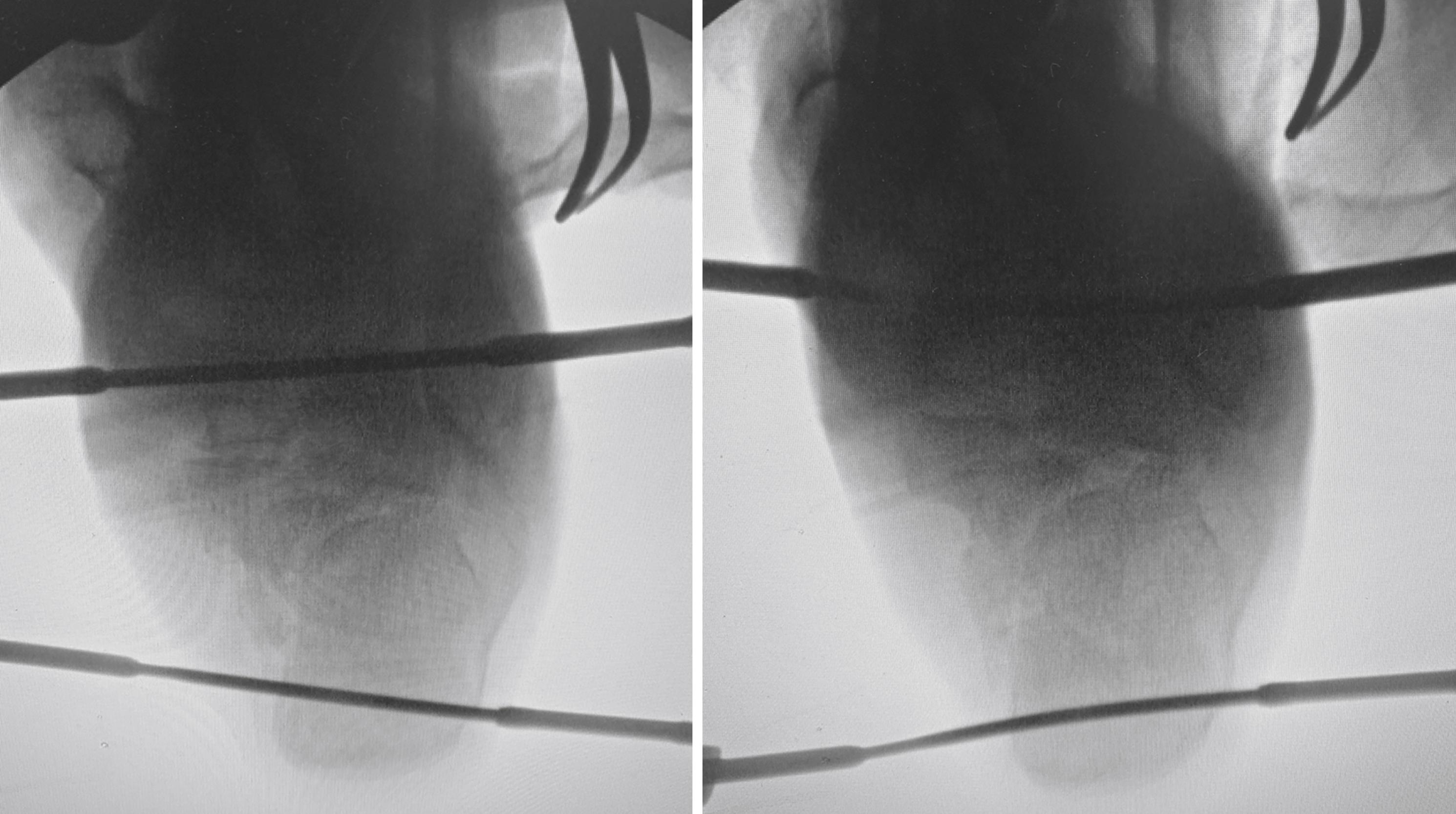
A 2.0-mm threaded Kirschner wire can be inserted into the posterior facet and used as a joystick.
Make a 1-cm incision in the lateral skin so that a Freer elevator or tonsil clamp can be inserted under the posterior facet through the primary fracture line ( Fig. 89.21 ). Under fluoroscopy, the posterior facet fragments can be elevated into appropriate position. Cannulated or solid screws (4.0 mm) can be placed from lateral to medial, anchoring the posterior facet to the sustentaculum tali ( Fig. 89.22 ).
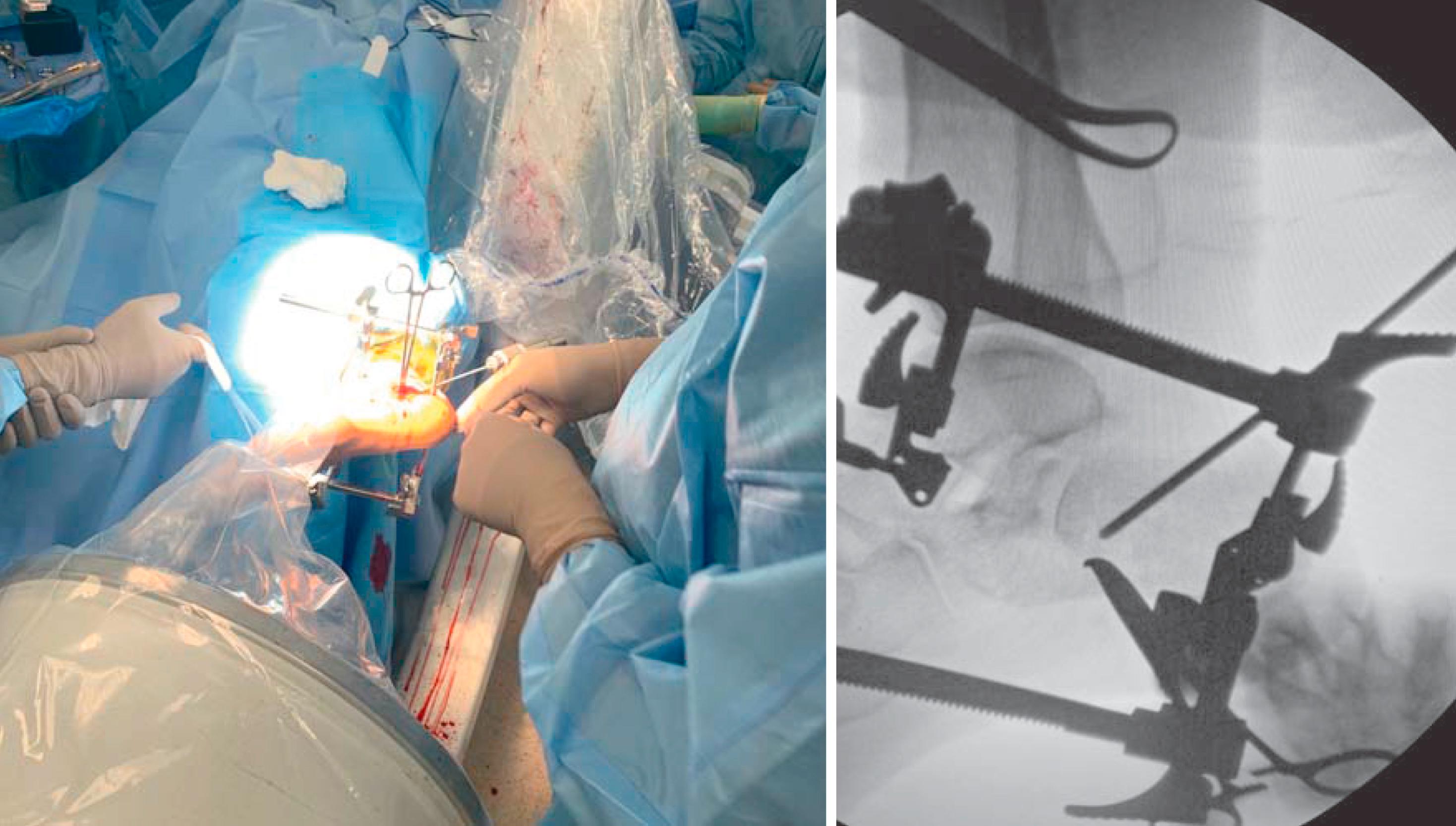
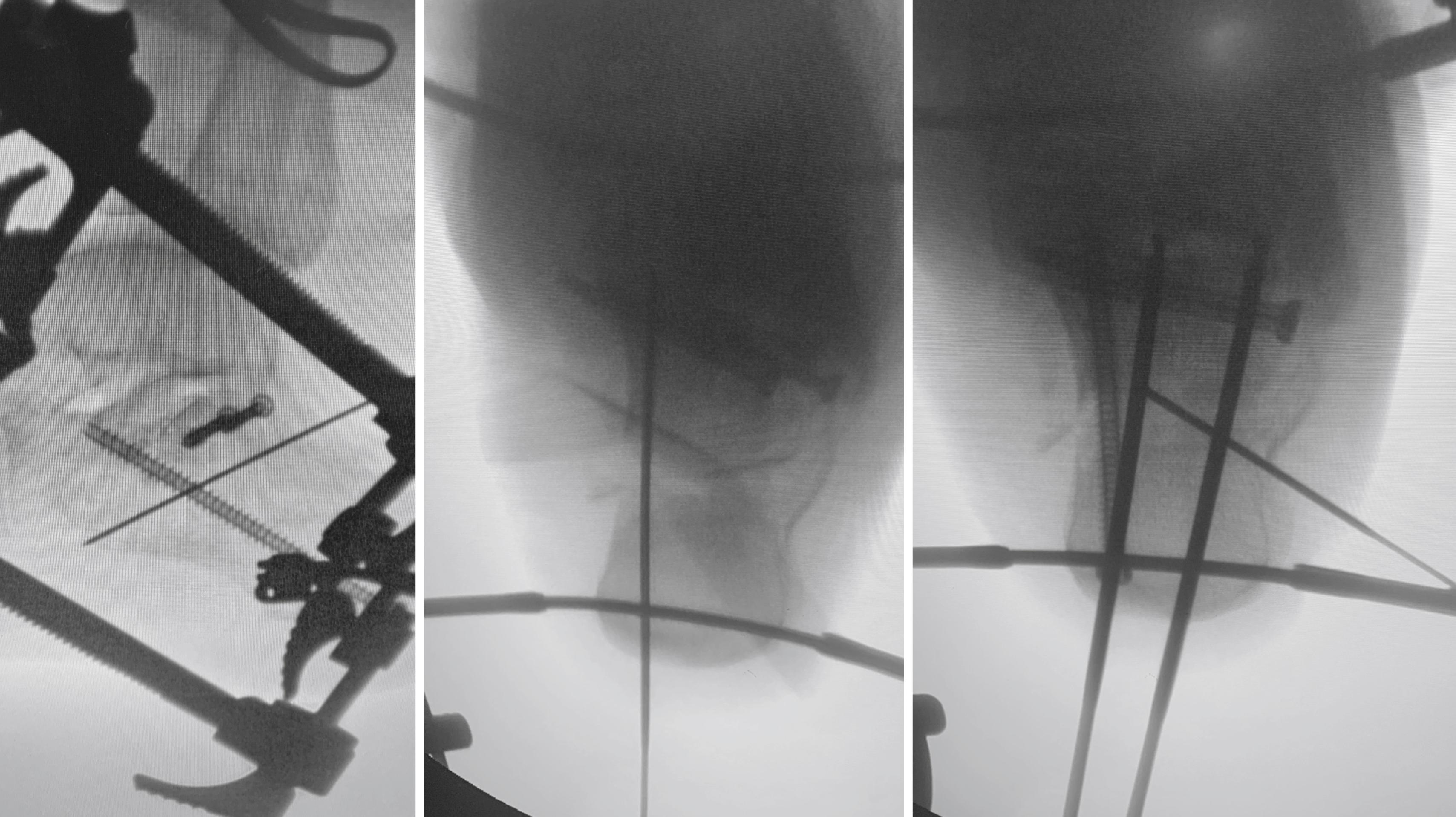
Insert three larger cannulated screws (5.0, 6.5, or 7.0 mm) from the tuberosity into the sustentaculum, under the posterior facet, and into the anterior process, respectively, based on fracture morphology, to maintain the restored anatomic parameters ( Fig. 89.23 ).
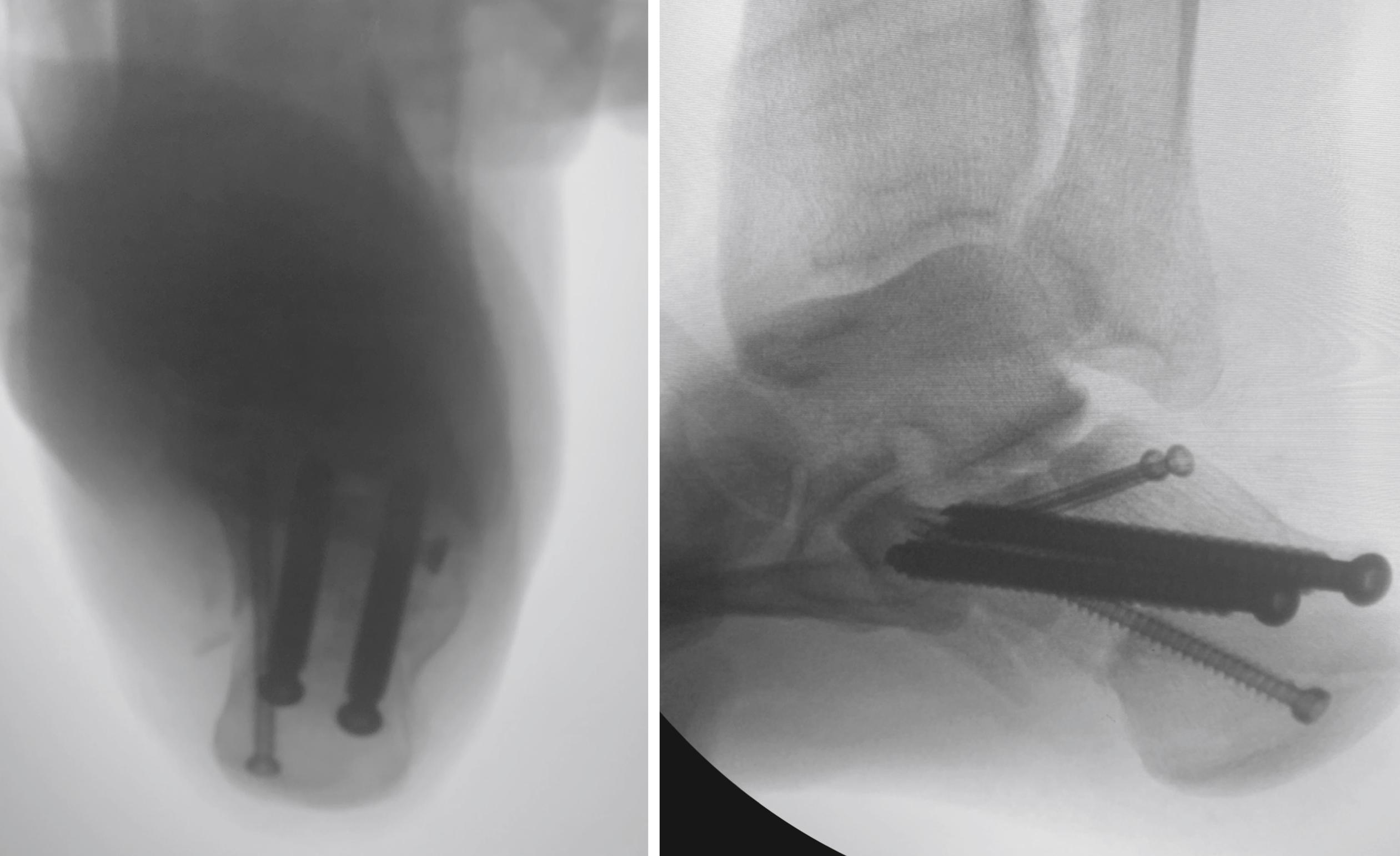
Soft-tissue edema and contusion are inherent aspects of calcaneal fractures. Operating through edematous soft tissue, especially in this area with a tenuous blood supply and no muscle between the skin and bone, entails risk of wound necrosis, dehiscence, and infection. After a standard, extensile, L-shaped approach with two-layer flap closure, wound complications developed in 25% of patients, with 21% requiring surgery for these complications. Other reported rates of marginal wound necrosis vary from 2% to 11%, and soft-tissue infection rates can be as high as 7%. Risk factors for wound complications include diabetes, smoking, open fracture, single layer closure, extended time between injury and surgery, and high body mass index. Although the incidence of mild wound problems is high, serious complications can be minimized in several ways:
Wound problems, particularly with fractures of the calcaneus, occur more frequently in active smokers. Patients should be advised not to smoke in the perioperative period and should be informed of the consequences of doing so before surgery is planned.
Carefully retracting the soft tissues and maintaining a full-thickness flap with the extensile approach are crucial.
A drain under the lateral flap may be considered to prevent hematoma formation postoperatively.
A two-layer closure should be performed, closing the wound from both ends to the middle. Throwing all of the sutures first and then tying allows less handing of the soft tissues.
Sutures should be left in place for 2 to 3 weeks until the wound is healed, and motion exercises should be avoided during that time to lessen shear forces under the flap.
Loss of reduction of major fragments can occur if weight bearing is initiated too early. Patients should be kept non–weight bearing for a minimum of 6 to 8 weeks to minimize this complication.
Accurately restoring the proper valgus alignment of the tuberosity fragment is essential. Patients tolerate varus malrotation poorly. Intraoperative Harris radiographs should be obtained to minimize this complication.
Sural nerve and peroneal tendon injuries may occur. The sural nerve should be protected at the proximal and distal extremes of the wound in an extensile approach. The sural nerve was shown to be directly under the sinus tarsi surgical incision in 70% of cases reported by Li et al. and should be identified and protected. Peroneal tendons are particularly vulnerable, especially if dislocated, because the extensile flap is elevated over a protruding lateral wall. Limited periosteal elevation and careful retraction should prevent this complication. Peroneal tendons also can subluxate or dislocate out of the fibular groove from the force of the injury. In one study, this occurred in 28% of patients with calcaneal fractures but was addressed in only about 10% of the patients who were treated operatively. Peroneal subluxation or dislocation may lead to later symptoms if missed.
Significant controversy remains over the results of nonoperative versus operative treatment. Lack of standardization of results has made it difficult to compare studies that have evaluated outcomes. Numerous studies support the principle that if nonoperative treatment is chosen, early mobilization improves long-term results. Although long-term studies have shown up to 76% good results with early mobilization of displaced intraarticular fractures, other, more recent studies have been considerably more pessimistic about closed treatment.
The results after operative treatment also vary, but most authors judge results by the quality of reduction of the posterior facet. Essex-Lopresti stated that 80% of patients younger than age 50 years who had “successful reduction” had satisfactory results. Most modern studies that directly compare operative and nonoperative treatment conclude that functional outcomes are similar for both groups, but that complication rates are significantly higher in patients treated operatively. One study suggested, however, that there may be a trend for better outcomes in operatively treated patients in longer-term (8- to 10-year) follow-up, and another study showed that early complications do not affect long-term outcomes. These and other studies focusing on operative treatment show that patients with worse functional outcomes include those with a greater severity of injury, those with workers’ compensation claims, those involved in heavy labor, and those with bilateral injuries. It is important to note that many studies comparing operative to nonoperative treatment have relied on the extensile lateral approach, whereas more limited techniques of surgical intervention have not been directly compared to nonoperative treatment in a large randomized trial.
Although the debate over open or closed treatment of calcaneal fractures may continue for some time, most authors agree that the inability to surgically obtain an anatomic reduction of the posterior facet is probably associated with a worse outcome than closed treatment. Overall, although there is moderate evidence that there is not a significant difference in pain and functional outcome between operatively treated and nonoperatively treated patients, operative treatment may improve subtalar motion and allow patients to wear regular shoes and return to work. Overall economic impact may be less in operatively treated fractures, especially when costs related to time off from work are included.
Other studies of ORIF through an extensile lateral approach show 73% to 75% good or excellent results, with subjective results clearly better at 10-year than 3-year follow-up. In a study with 10- to 20-year follow-up, 29% of patients required an arthrodesis procedure, with a higher percentage for patients with Sanders type III fractures than those with type II fractures. Patients did reasonably well if they did not develop posttraumatic arthritis, with 77% scoring within the normal range on the 36-Item Short Form Health Survey (SF-36). A steep learning curve exists for operative treatment of calcaneal fractures, with significantly greater percentages of good and excellent results reported with greater surgeon experience. Ahn et al. suggested that an initial learning period of 20 cases is needed to improve reduction parameters. It is difficult to obtain good results with Sanders type IV fractures. In a small prospective randomized study in which patients with Sanders type IV fractures were treated with either ORIF or ORIF with primary arthrodesis, outcomes were similar for both groups, but patients with ORIF and primary arthrodesis had a shorter healing time.
Operative fixation through a limited lateral approach can produce outcomes similar to those of the extensile lateral approach, with good or excellent results in 59% to 84% of patients, a high accuracy of reduction, and a wound complication rate of 0% to 15%. In multiple retrospective reviews comparing outcomes of calcaneal fractures treated with an extensile lateral approach with those treated with a limited lateral approach, functional and radiographic outcomes were similar; however, those treated with the limited lateral approach had a lower incidence of wound complications and secondary surgeries. With a combined medial and lateral approach, 77% good or excellent results have been achieved. Marsh described 182 calcaneal fractures treated with percutaneous techniques and at final follow-up reported that 54.5% of patients had a residual pain level of 3 or lower.
Percutaneous fixation, with and without the use of arthroscopy, external fixation, and/or dual C-arms, has been reported to lead to reasonable functional outcomes, with 74% to 100% of patients returning to work and a 0% to 15% infection rate. Results were similar when compared with a historical control of patients who had standard ORIF, but patients with percutaneous reductions went back to work earlier and had better range of motion of the subtalar joint. When calcium sulfate cement grafting was added to percutaneous fixation, patients could bear weight earlier and had better range of motion and better outcome scores than those with open reduction without a difference in the quality of reduction.
Most authors reported that regardless of the type of treatment, symptoms should improve for at least 2 years and possibly 6 years. Although anatomic reduction of the posterior facet is correlated with better functional outcomes, eventually enough pain develops in some patients to warrant further treatment.
Regardless of treatment method, chronic pain develops in some patients, limiting their capacity to work and enjoy life. Late problems leading to a painful outcome include posttraumatic arthrosis of the subtalar joint, lateral subfibular impingement with or without problems of the peroneal tendons, anterior ankle impingement from loss of the normal plantarflexed position of the talus, tibial or sural nerve complications, fat pad atrophy, and chronic regional pain syndrome. Classification of calcaneal malunions includes type I, lateral wall exostosis without subtalar arthrosis ( Fig. 89.24A ); type II, lateral wall exostosis with subtalar arthrosis ( Fig. 89.24B ); and type III, lateral wall exostosis, subtalar arthrosis, and varus malunion of the calcaneus ( Fig. 89.24C ).
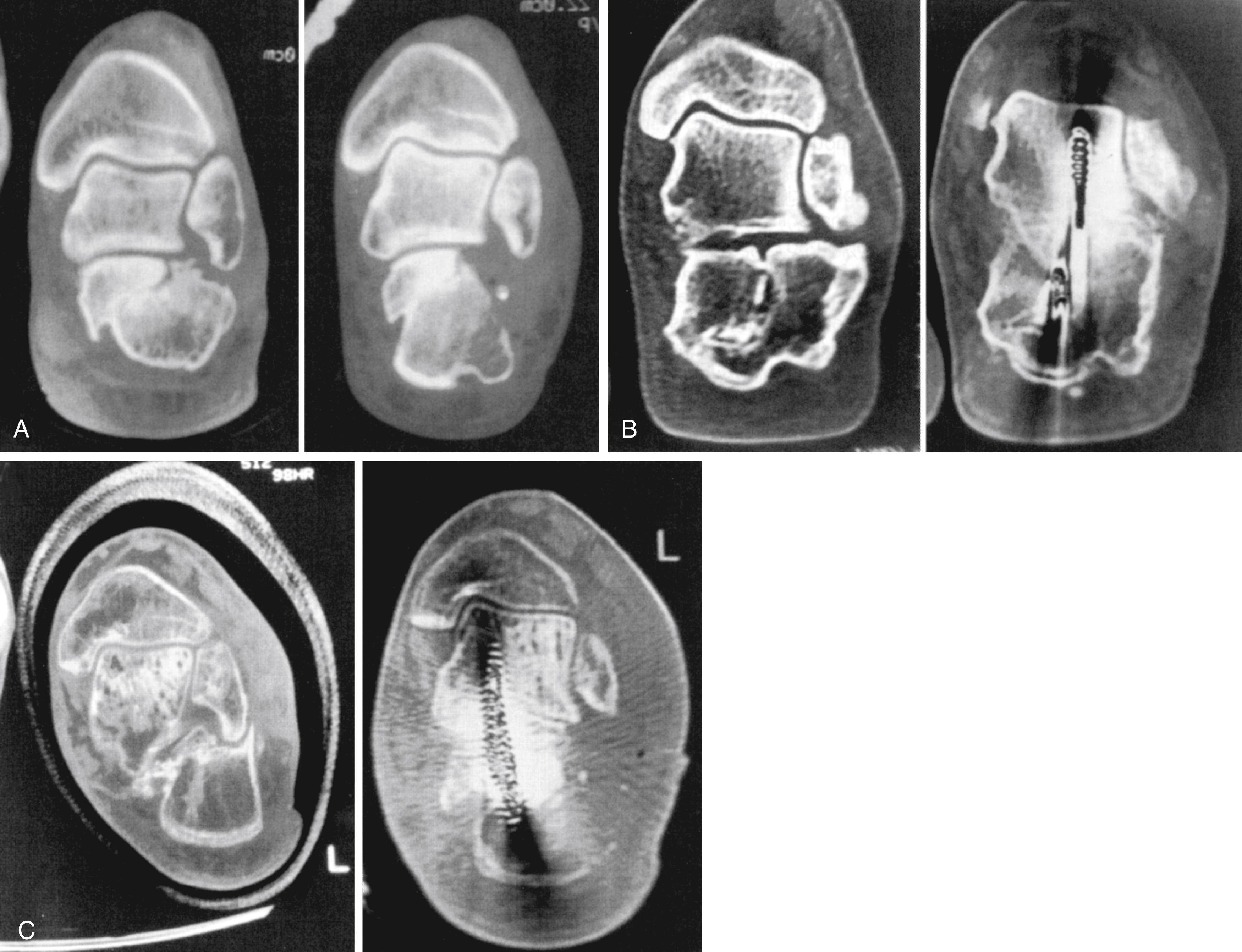
Patients with chronic lateral subtalar pain should be evaluated for two problems: posttraumatic arthrofibrosis or arthrosis and lateral calcaneofibular impingement, the latter of which rarely occurs in isolation. A combination of CT and selective subtalar injection of a local anesthetic can be helpful in determining the cause of the pain. Some patients have a congruous subtalar joint but have impingement or displacement of the peroneal tendons by the extruded lateral calcaneal wall, a type I malunion. This excess bone can be removed through a curved lateral incision along with deepening of the fibular groove for the peroneal tendons ( Fig. 89.25 ). Removing this bone allows the peroneal tendons to assume a more normal position inferior to the fibula and narrows the heel, which assists with shoe fitting and lessens irritation from the lateral shoe counter; this was helpful in 79% of patients in one report. In another report, patients who had this procedure in isolation did not do well if they had concomitant subtalar arthrosis. More commonly, this procedure is done in conjunction with subtalar arthrodesis because many patients have both subtalar arthrosis and lateral impingement.
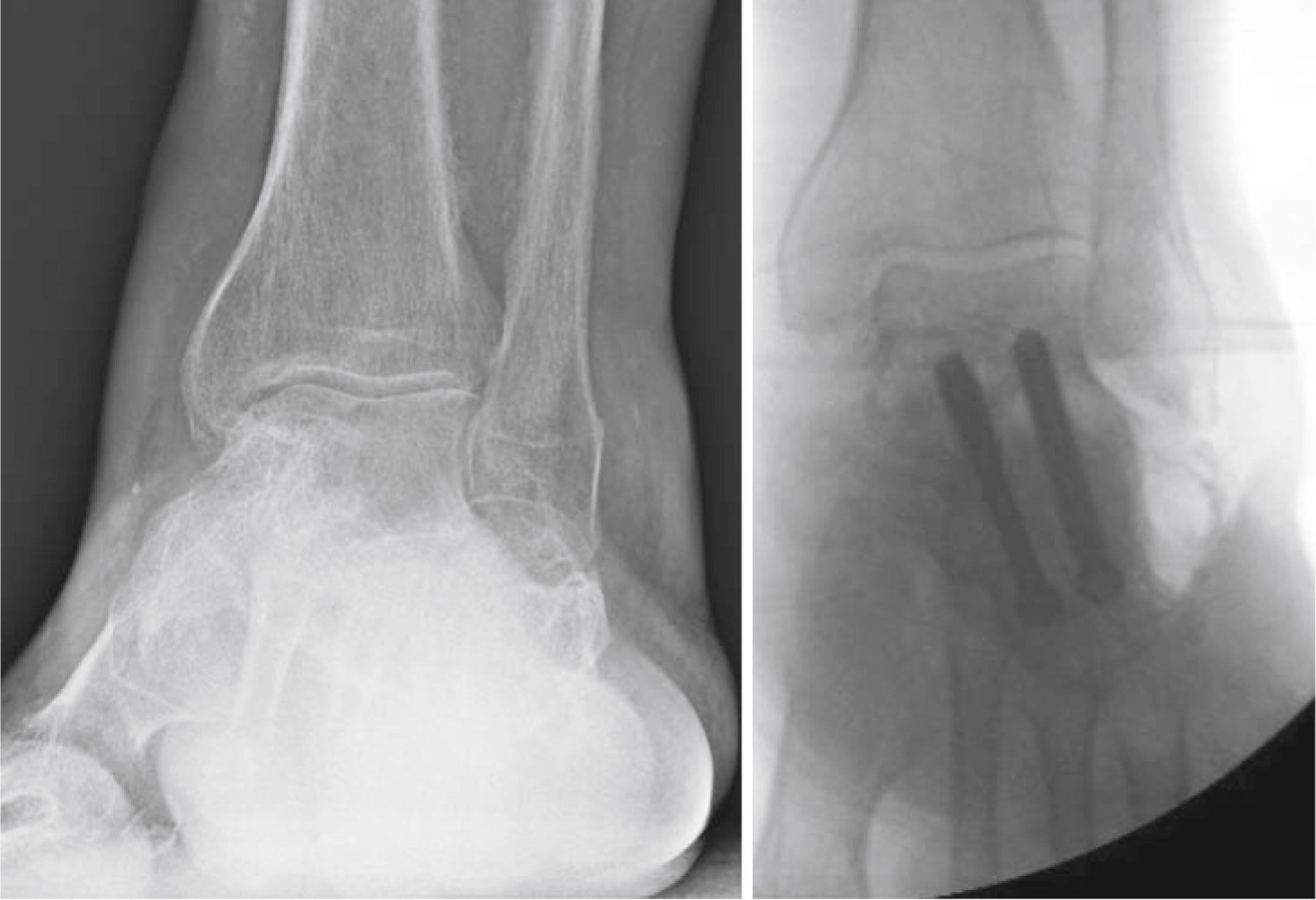
(Braly, Bishop, and Tullos)
The procedure can be done with the patient in the lateral position or supine. If supine, place a roll under the ipsilateral hip for greater exposure of the lateral aspect of the foot and ankle. Apply and inflate a pneumatic thigh tourniquet.
Make a curved incision just plantar to the course of the peroneal tendons, extending from the posterior aspect of the lateral malleolus to the region of the calcaneocuboid joint ( Fig. 89.26A ). If previous subtalar fusion or open reduction has been performed, attempt to use the existing incision.
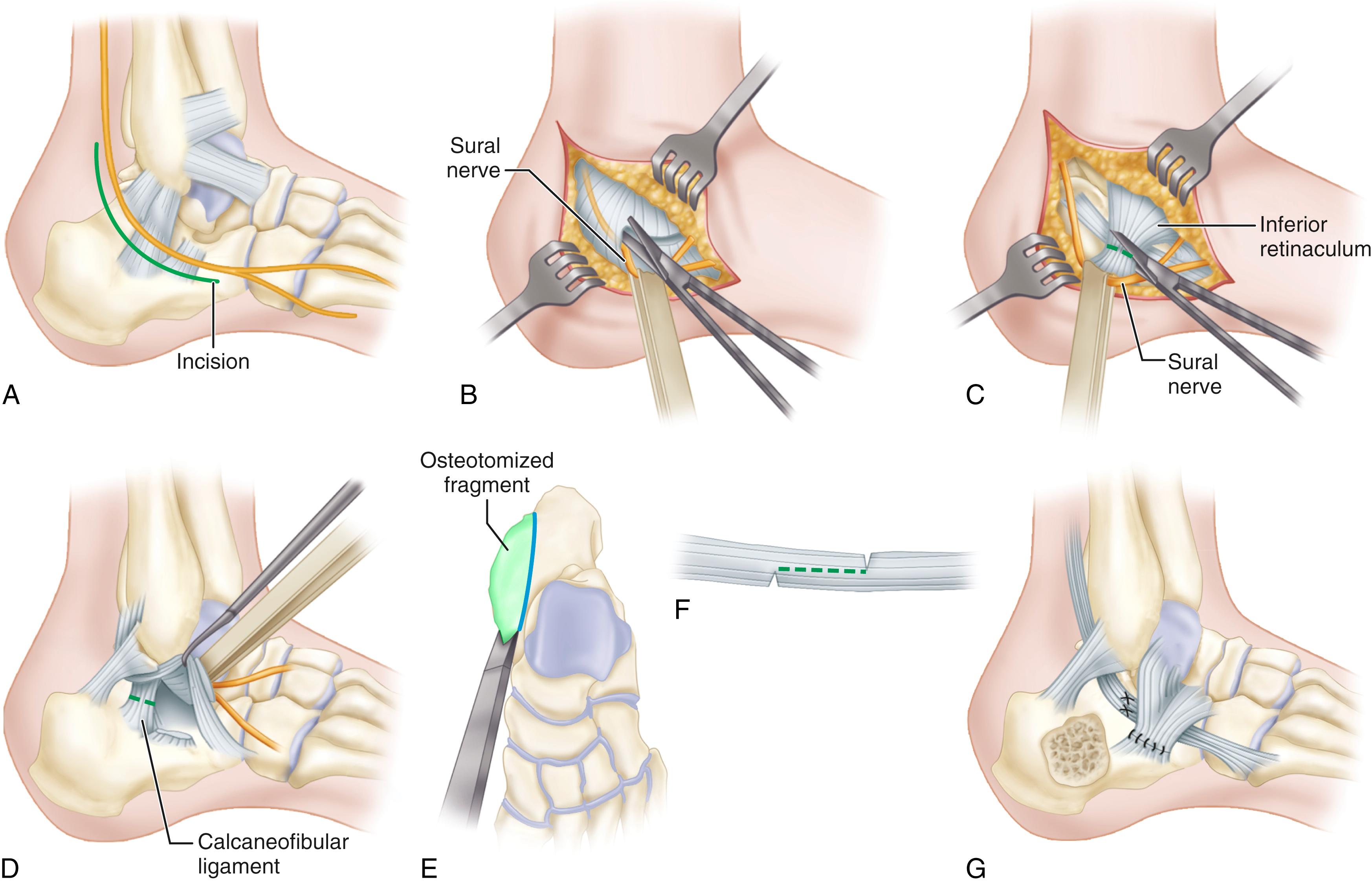
Identify and release the sural nerve from surrounding scar tissue to more normal anatomy proximally and distally ( Fig. 89.26B ).
Excise any neuromas present and dissect the nerve back to areas where the potential for external irritation over bony prominences during shoe wear is minimized.
Incise the peroneal tendon sheath, if intact, taking care not to divide completely the superior retinaculum proximally.
Perform a tenolysis ( Fig. 89.26C ).
With the peroneal tendons and sural nerve retracted, incise the calcaneofibular ligament ( Fig. 89.26D ).
Incise longitudinally the floor of the peroneal tendon sheath and the periosteum over the lateral calcaneus.
With subperiosteal dissection, expose the prominent lateral bony mass of the calcaneus and excise it ( Fig. 89.26E ). Do not attempt to reconstruct the calcaneofibular ligament.
The amount of bone removed from the calcaneus depends on the degree of lateral impingement of the peroneal tendons and sural nerve evident intraoperatively and on preoperative radiographs. Attempt to narrow the heel, at least laterally, to a more normal width, avoiding violating the subtalar and calcaneocuboid joints during bony resection. Smooth all rough edges with a rongeur and a rasp.
Repair the reflected overlying periosteum or tendon sheath over the bed of the ostectomy.
If any raw cancellous bone is left exposed, apply bone wax for hemostasis.
Close the wounds in routine fashion and apply a soft, compressive dressing.
If the peroneal tendons are dislocated, Braly et al. recommended Z-lengthening of both tendons before locating them behind the lateral malleolus ( Fig. 89.26F ); we do not routinely lengthen these tendons. The fibular groove can be deepened in cases of chronic peroneal dislocation.
Repair the retinaculum or reconstruct it using an osteoperiosteal strip from the lateral malleolus, as described by Zoellner and Clancy ( Fig. 89.26G ), after the ostectomy.
Early motion and progressive weight bearing as tolerated are encouraged 2 to 3 days after surgery. If peroneal work was performed, immobilization may be continued until the wound is healed before progressing range of motion and protected weight bearing.
With the realization that symptoms should improve for at least 2 years, and as long as a patient is progressing in activity level and work capability, arthrodesis may be avoided, although the psychosocial complications of prolonged disability are profound. If a patient fails to progress with conservative treatment (e.g., bracing, antiinflammatory medications), arthrodesis should be considered. It has been shown that the longer the interval between the injury and the salvage procedure, the longer the interval until the patient returns to full activity or work.
In patients who are candidates for subtalar arthrodesis, bilateral standing radiographs should be scrutinized carefully. The talar angle of declination should be evaluated because it measures excursion of the tibiotalar joint in extension ( Fig. 89.27 ). For patients with a depressed talar angle of declination, Carr et al. modified a procedure originally described by Gallie, the subtalar distraction bone block arthrodesis ( Fig. 89.28 ).
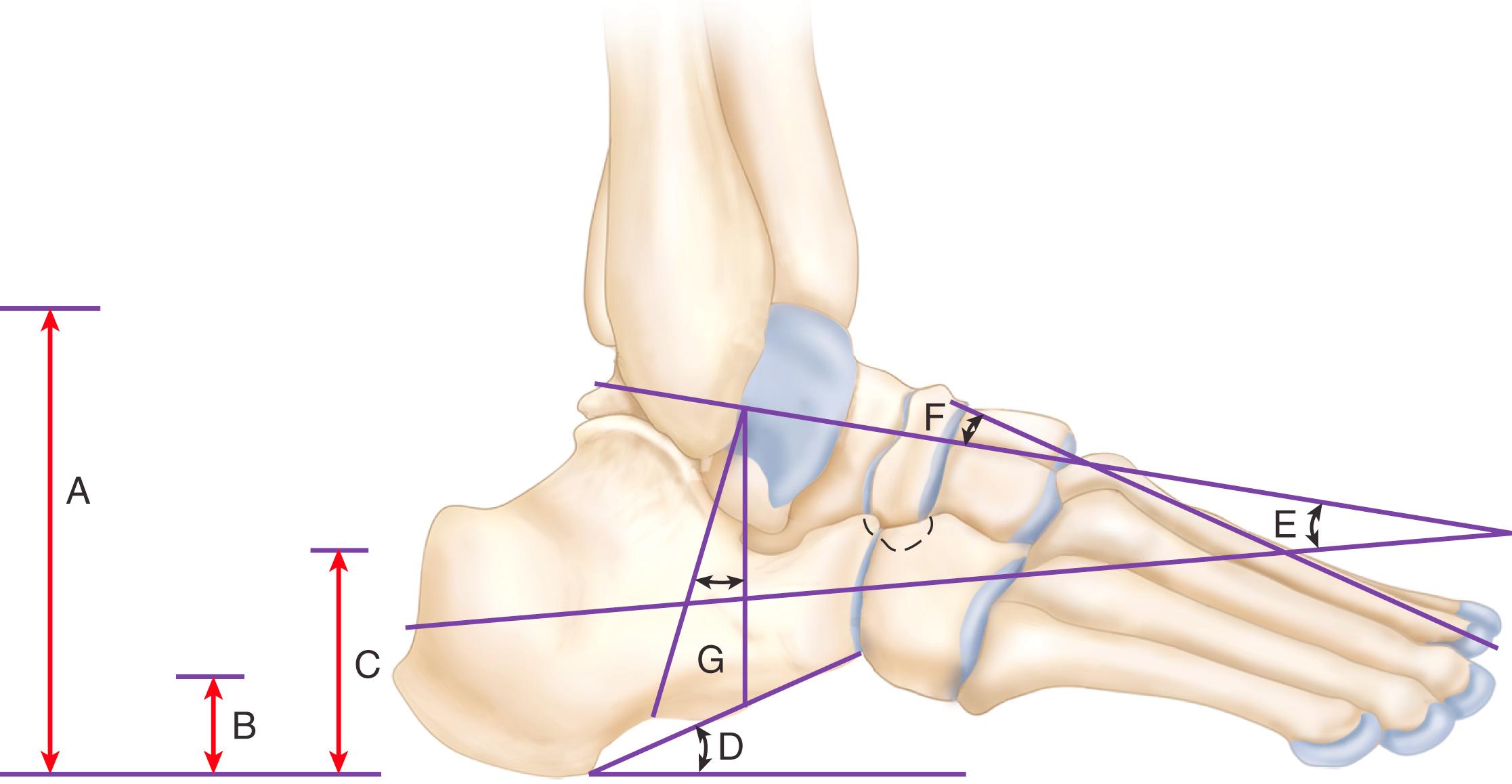
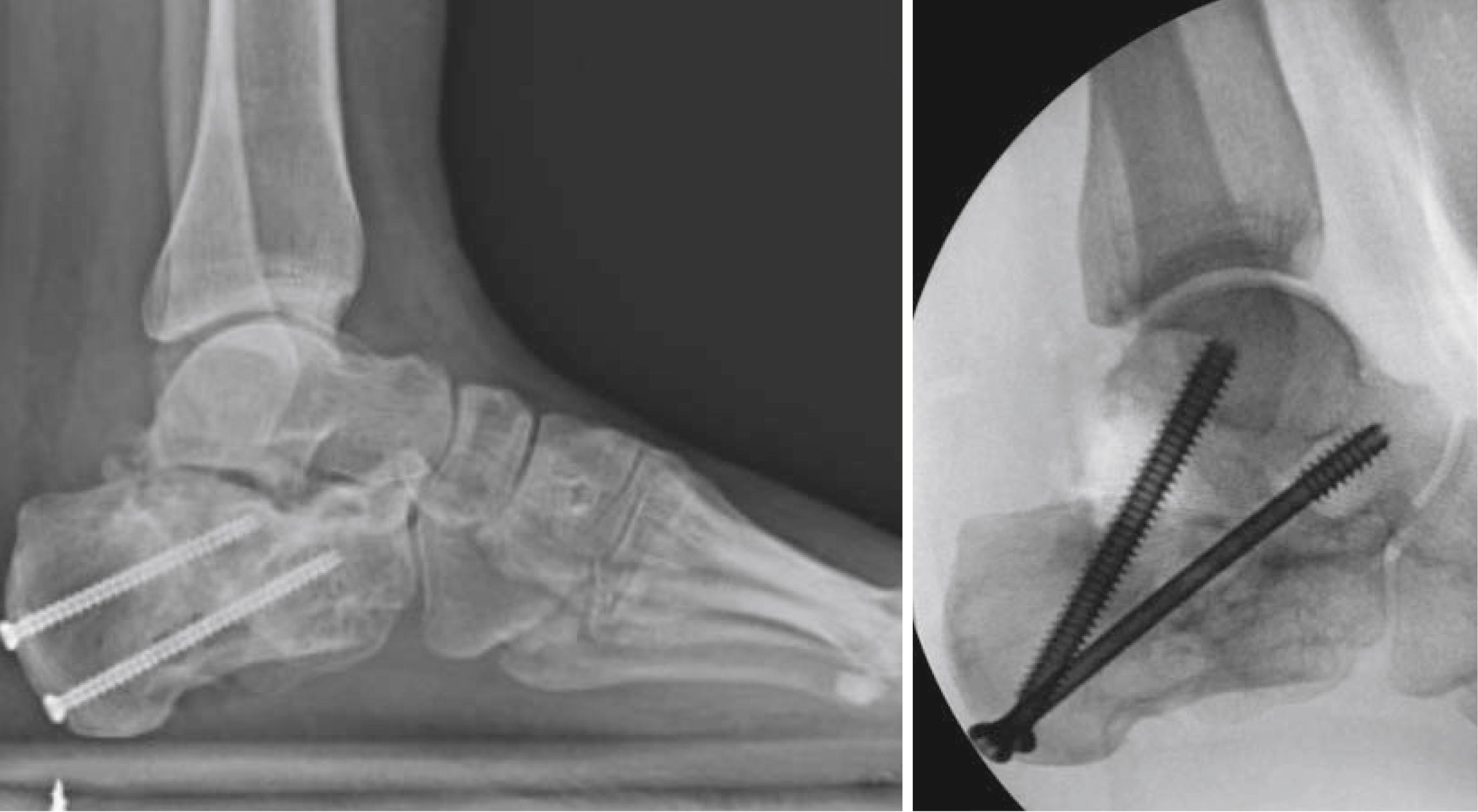
Although the procedure is technically demanding, resulting postoperative appearance of the foot and improved ankle dorsiflexion may be impressive. A number of studies have demonstrated the usefulness of subtalar distraction bone block arthrodesis for the late complications of calcaneal fractures. Failures occurred in patients with transverse tarsal joint arthritis, malunions, and nerve problems. Functional outcomes were better in patients who had a late subtalar arthrodesis after ORIF than in those who were initially treated nonoperatively.
If calcaneal height is normal or minimally depressed and there are no anterior ankle joint impingement symptoms, we prefer in situ subtalar arthrodesis. Lateral wall decompression can be added if widening of the calcaneus is causing subfibular impingement, and use of this local graft for distraction has been shown to have outcomes similar to iliac crest bone grafting. This procedure can be helpful for patients with subtalar arthrosis after calcaneal fractures. No correlation has been identified between final outcome and talar angle declination, talar height, or calcaneal width. Peroneal tendon and subfibular impingement, ankle tenderness, sural nerve injury, and patient smoking all were statistically associated with lower scores.
(Carr et al.)
Position the patient prone. Prepare and drape the posterior iliac crest and leg.
Under tourniquet control, use a longitudinal posterolateral Gallie type of approach to the subtalar joint. Use a vertical incision because, after increasing the height with a bone block, a transverse incision will be more difficult to close. Identify and protect the sural nerve in the proximal incision. Alternatively, it can be excised and buried in surrounding muscle.
Subperiosteally expose the lateral calcaneal wall and excise to a more normal width with a wide sharp osteotome. This step should ensure peroneal and fibular decompression.
Identify the subtalar joint.
A femoral distractor, Kirschner wire distractor, or external fixator with half-pins in the medial subcutaneous tibia and medial calcaneus may need to be applied for exposure. The medial application helps to correct hindfoot varus.
Apply distraction and denude the subtalar joint to subchondral bone. Use a laminar spreader to aid in subtalar joint exposure. Direct attention to any heel varus or valgus at this point and, if necessary, correct by manipulation. Obtain intraoperative radiographs to ensure correction of the lateral talocalcaneal angle (normally 25 to 45 degrees). A percutaneously placed Kirschner wire distractor can be used to hold the distraction and allow easier instrumentation ( Fig. 89.29 ).
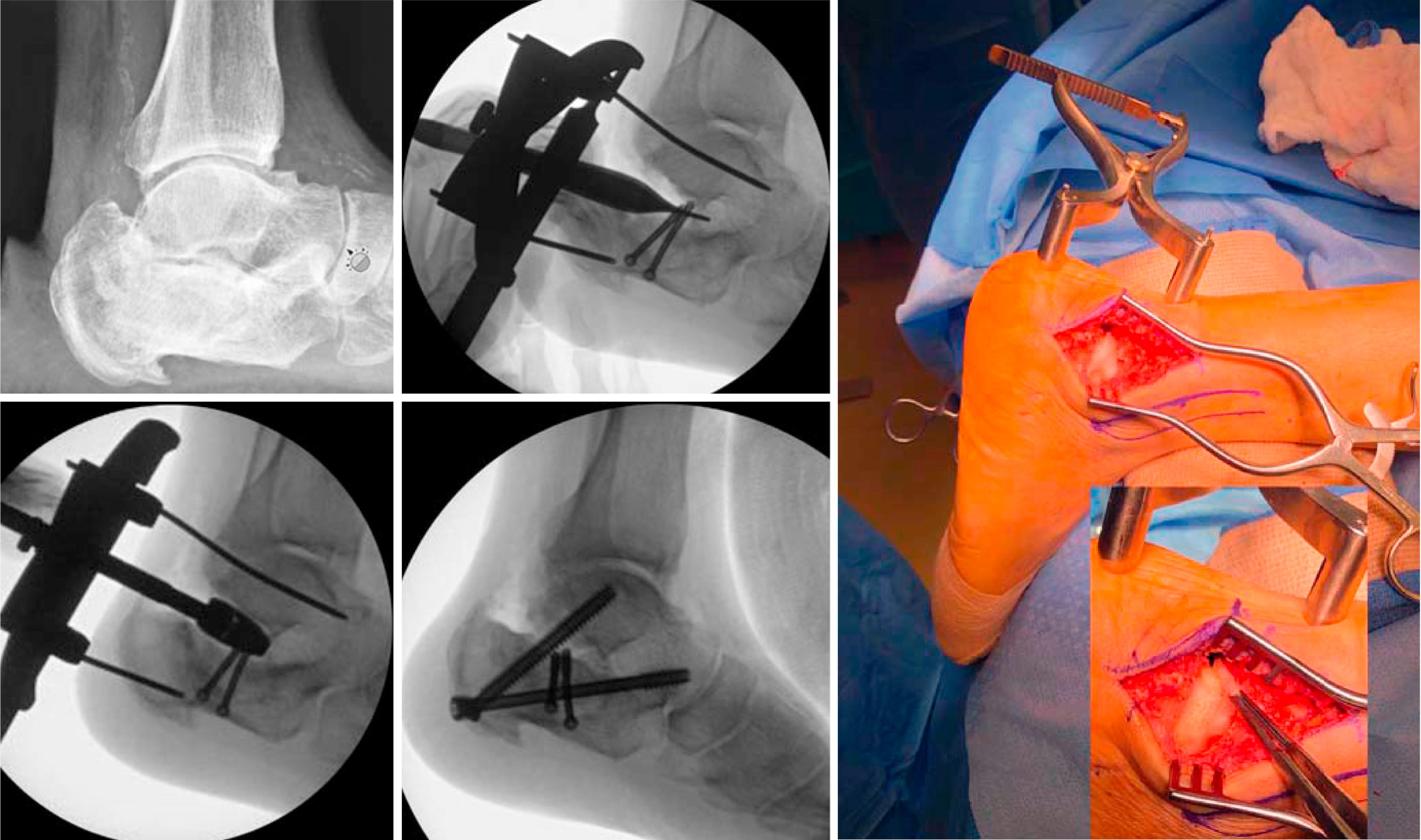
Measure the subtalar joint gap and harvest an appropriately sized tricortical posterior iliac crest graft. A block 2.5 cm in height may be required for severe deformities. Two separate pieces may be required to fill the gap completely and help prevent late collapse into varus or valgus. In some cases, the excised lateral wall can serve as sufficient graft material for the measured gap.
Release the distraction forces.
Insert a partially threaded cannulated screw (6.5 or 7.0 mm) from the tuberosity into the talar neck to increase talar declination, followed by a fully threaded screw laterally through the graft and into the talar body. A supplemental screw can be placed from the anterior process into the talar head.
Obtain final radiographs (lateral and axial views) to confirm correct positioning.
Close the wound in layers with interrupted nylon on the skin.
The patient is kept in a short leg cast or splint for 6 to 8 weeks followed by weight bearing in a fracture boot for an additional 4 to 6 weeks.
Calcaneal fractures can be extraarticular (not involving the subtalar joint) or intraarticular (involving the subtalar joint). Extraarticular fractures include fractures of the calcaneal tuberosity, the sustentaculum tali, and the anterior process of the calcaneus.
Avulsion fractures of the calcaneal tuberosity are rare and are thought to be insufficiency fractures through osteoporotic bone and in patients with diabetes. A classification scheme has been proposed, with three types ( Fig. 89.30 ) : type I is a sleeve fracture in which a small piece of cortical bone is avulsed; type II is a beak fracture with an oblique fracture line that exits close but posterior to the posterior facet; and type III is an infrabursal fracture that is an avulsion off the middle third of the posterior aspect of the tuberosity. Type II fractures may require prompt reduction and fixation because the fracture fragment may cause soft-tissue compromise ( Figs. 89.31 and 89.32 ). Fixation often is carried out with screws and plates ( Fig. 89.33 ). Loss of reduction can occur because of the strong pull of the Achilles tendon; suturing the tendon to bone using suture anchors or bone tunnels to augment screw fixation can provide greater fixation strength. In addition, lengthening of the gastrocnemius-soleus muscle (Strayer procedure, see Chapter 33 ) in patients with gastrocnemius tightness can help to reduce the deforming force. Because of dissatisfaction with the maintenance of reduction with screws and plates, a lateral tension band technique also has been used ( Fig. 89.34 ). At our institution, avulsions with small to moderate pieces of bone are treated with excision of the bone fragment, smoothing of the dorsal calcaneal surface, and a secondary repair of the Achilles tendon to the remaining calcaneus with suture anchors, often accompanied by a gastrocnemius recession.
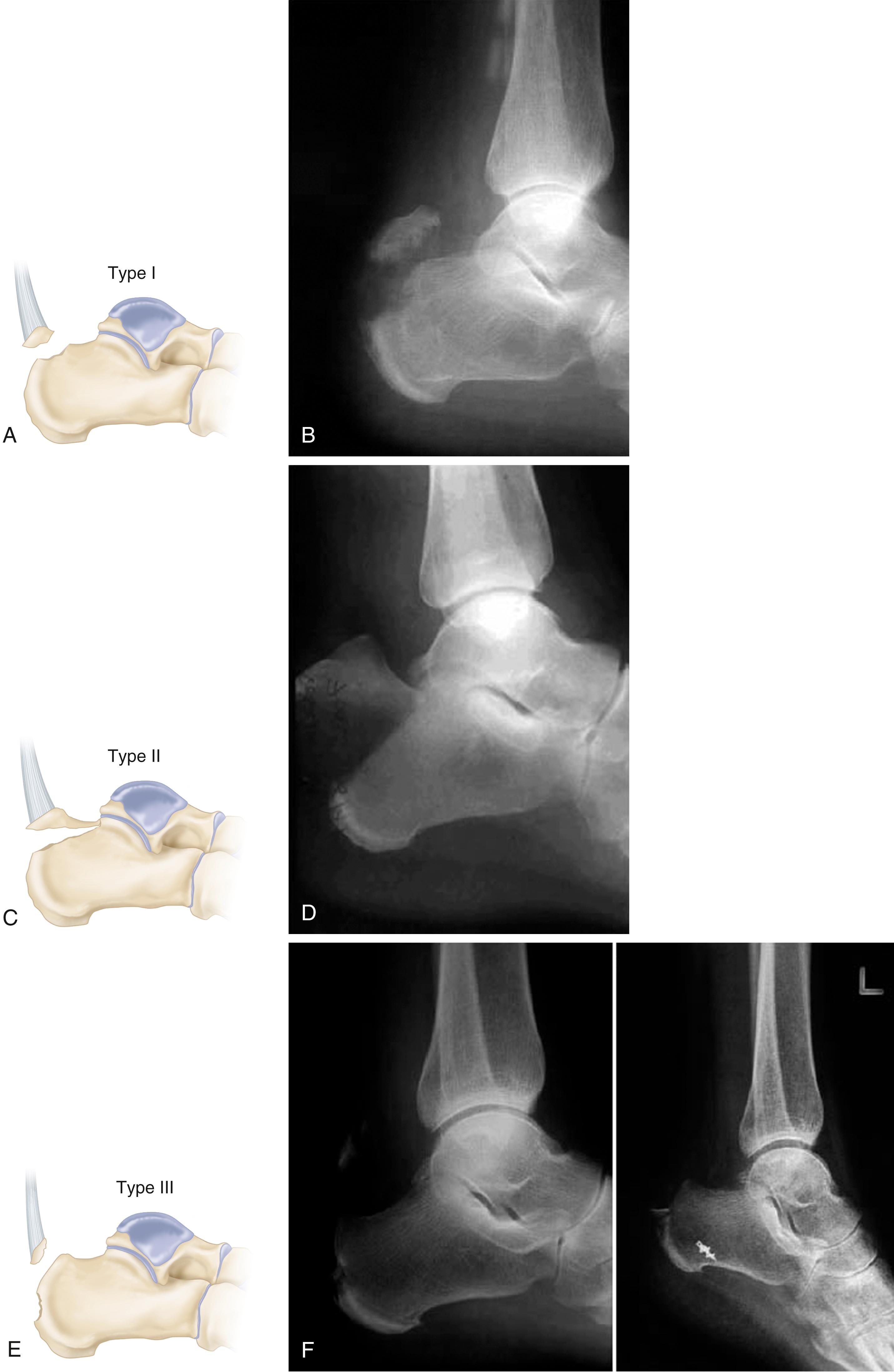
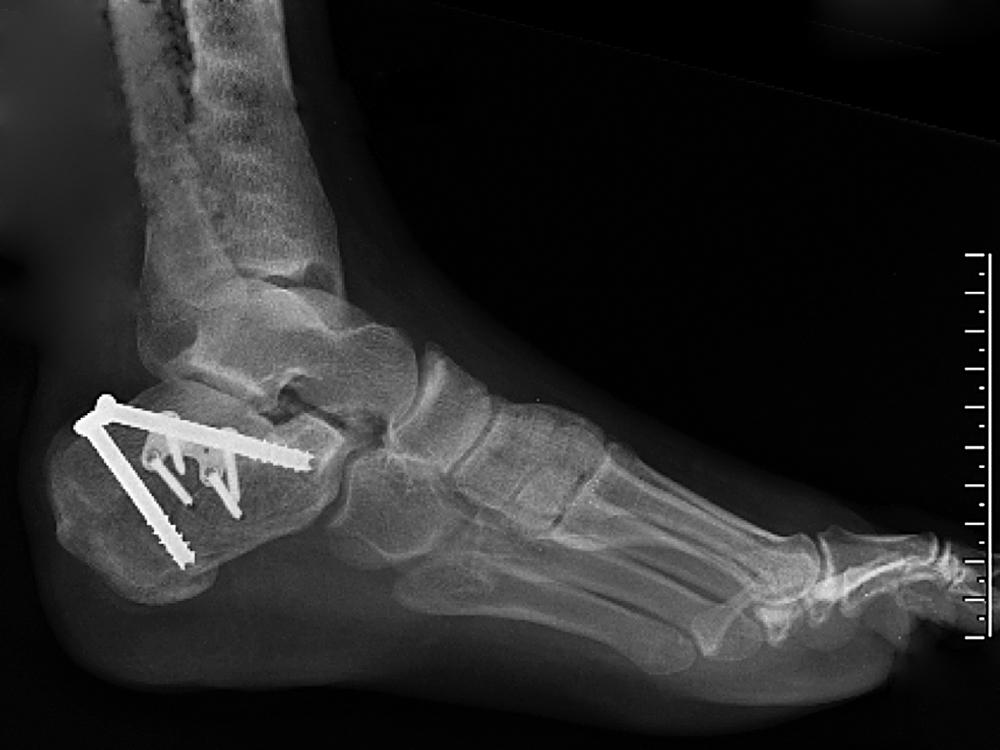
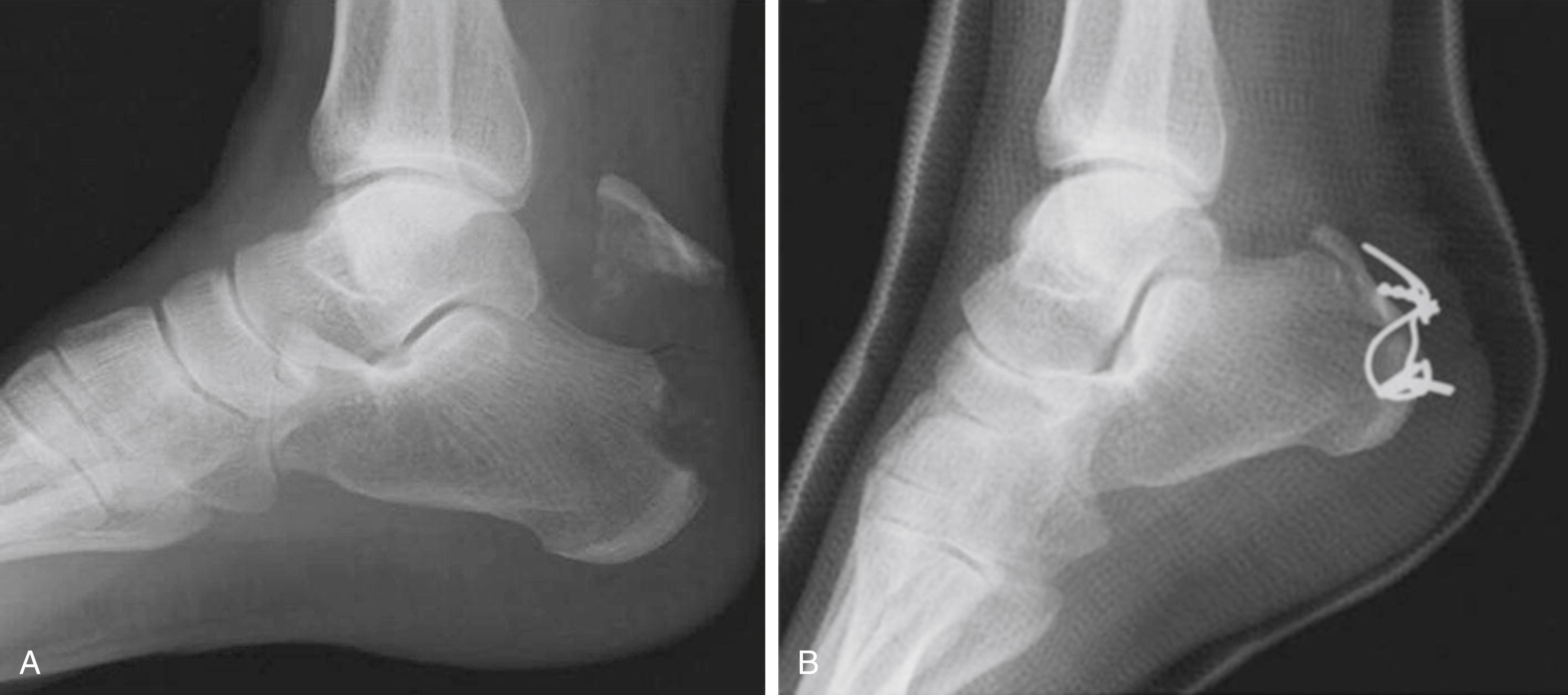
Isolated fractures of the sustentaculum tali are rare and often are missed on initial radiographs ( Fig. 89.35 ). Although this is considered to be an extraarticular fracture, it can often involve the joint. These fractures often are associated with ipsilateral foot and ankle fractures, and direct ORIF, although a medial approach, yields good results. If not treated operatively, migration of the fragment from nonunion of this fracture can cause tarsal tunnel syndrome.
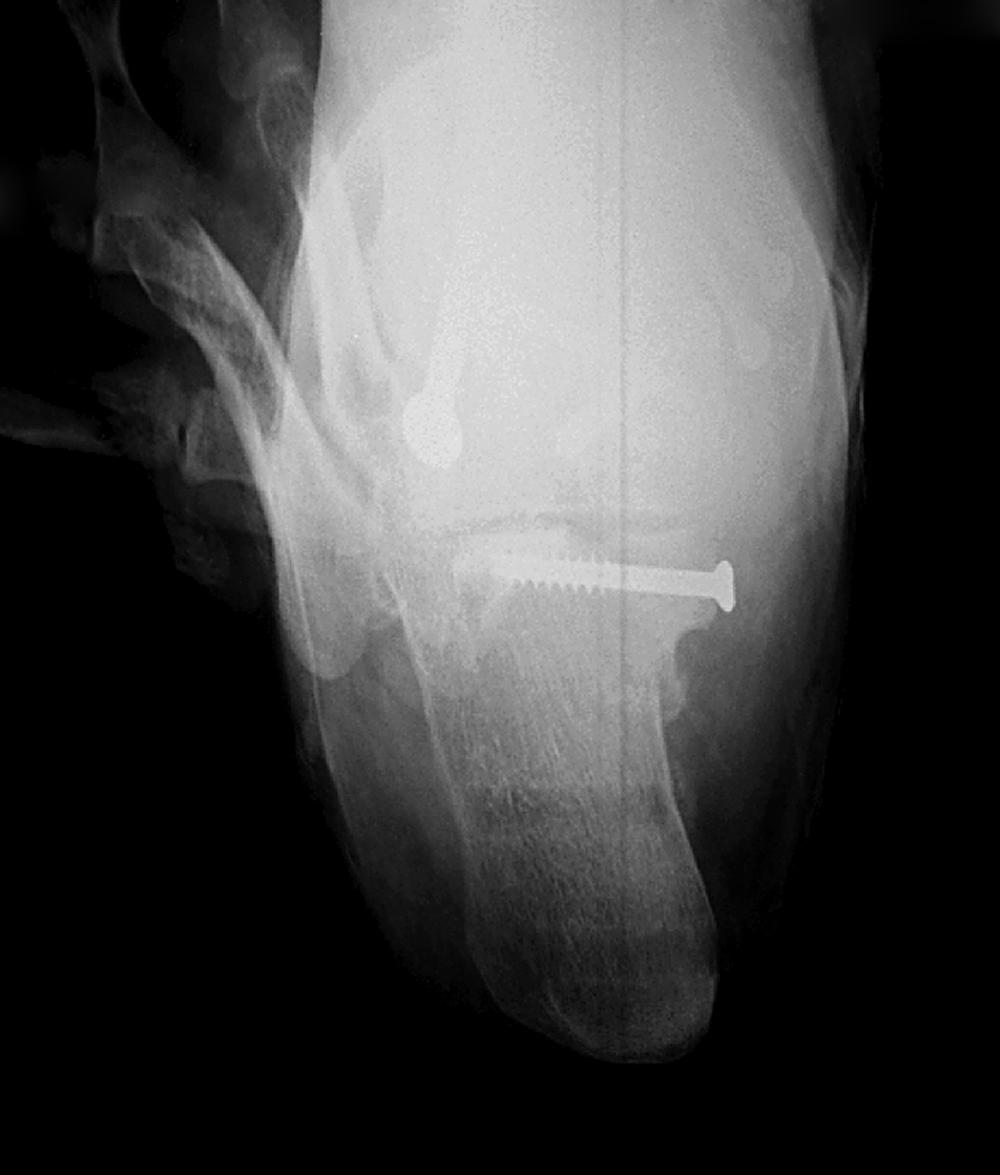
Become a Clinical Tree membership for Full access and enjoy Unlimited articles
If you are a member. Log in here